 By Pepper Parr By Pepper Parr
January 19th, 2017
BURLINGTON, ON
It came as a surprise to the city.
An inquiry from a reporter, it wasn’t us, to the city manager, asking why the Museum revealed that the Brant Museum had been closed since the beginning of the year.
 Museum Board has plans for a major upgrade to the Brant Museum – they closed the museum until they know what is gong to happen to their grant application. The Museum Board recently appeared before city council seeking assurances that the city would provide a letter that was needed to advance the application for significant federal grants that would cover the cost of the transformation the museum has planned.
A number of people from the Museum Board appeared and delegated but not one of them advised the city that they had closed the Brant Museum when Lakeshore Road was being rebuilt and that they just didn’t reopen it.
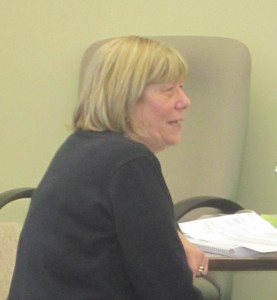 Barbara Teatero, Executive Director Museums Burlington So much for transparency – and it kind of shakes the confidence the city has in both the Executive Director and the Museum Foundation. Councillor Lancaster represents the city on the Burlington Museum Board – surely she would have known – did she lose her tongue?
The city spends about $600,000 on the museums – it was suggested that the budget be reduced given that there is now just the one museum and not two.
The city manager pointed out that the biggest expense is the cost of Barbara Teatero, the Executive Director. Fine – she has just half the work to do now – reduce her salary. Ms Teatero is due for retirement soon.
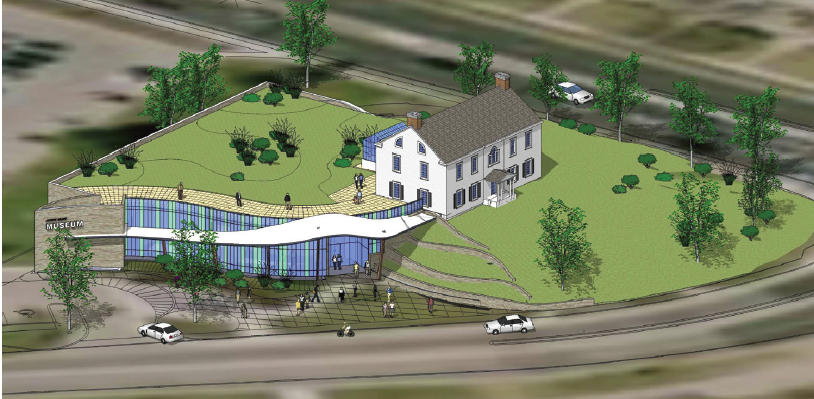 New look for the Brant Museum – closed now – will it ever re-open? There is no word on just how long the Museum is going to be closed. Nor has the city learned anything about what they plan to do if the federal funding does not come through – the due day for that announcement is January 25th – that would mean the decision has been made – they just aren’t saying anything yet.
The Mayor is scheduled to give his State of the City address on the 25th – that will be quite early in the day – and the MP for the city is not going to let the Mayor steal the thunder behind that announcement.

 By Pepper Parr By Pepper Parr
January 19th, 2017
BURLINGTON, ON
City council passed a budget that reflects an increase over last year of 4.42%
The budget decision was not unanimous – passed on a vote of 5-2.
Mayor Goldring said in his comments on the budget that this was the first time he recalls a budget coming out with a higher amount than they had when they started; in other words they increased the spending beyond wat staff had asked for.
Friends of Freeman got the $50,000 they needed; the seniors lucked out – no free transit for them.
More details to follow

 By Pepper Parr By Pepper Parr
January 19th, 2017
BURLINGTON, ON
City council will be meeting as a Committee of the While (COW) today to go through the Operating Budget; they have already decided on what the Capital budget is going to be.
The number floating around city hall at this point is an increase of 4.6% which is resulting in serious heart burn on the part of those who pay taxes and pay attention to this kind of stuff.
One of those people is Tom Muir, an Aldershot resident who has been tracking the goings on at city hall for more than 25 years.
In a recent note he sent to the members of council, the city manager and the city clerk Muir had this to say:
“I’m not going to repeat myself too much from last year, but the percent increases for the city are still on track to double in about 19 years or less.
“I wrote Council last year and the response I got was that they were concerned about it too, and were going to work on it over the coming year. Well, here we have the results. You still don’t get it.
“The city assumed inflation rate is 2%, but my pension increase, based on the CPI, only went up 1.4%, as did my wife’s’.
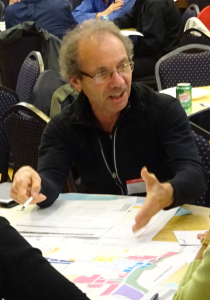 Tom Muir, an Aldershot resident who has been delegating to city council for more than 25 years – he is relentless. “In the Mayor’s December newsletter, he said that he thought the budget could be whittled down to something more like the 2%.
“I worked in government for 33 years, and went through a lot of budget cuts. The way it was done, if the guv was serious about it, was just to tell the managers and the finance people to cut the budget across the board to meet the target expenditure increase.
“No nonsense or sacred cows, except entitlements. Don’t get lost in every line item. Just do it at the high level.
“Then managers cut where you want, but just make the cuts.
“This is what is needed now. The idea that there is nothing left to cut is absurd.
“It’s all in the approach and the political will.”
Ward 5 Councillor Paul Sharman responded to Muir with the following:
 Ward 5 Councillor Paul Sharman was once a hard driving member of Council. He all but man-handled his fellow council members into a 0% increase in 2010. “You will appreciate that City operations and assets are quite complex. You also know from participating in DC (Development Charge) review committees that assessment growth has subsidized growth and Infrastructure renewal costs in the past, neither of which are reflected by inflation indicators.
“Of course Burlington assessment growth is quite low now, meanwhile we are trying to recover from decades of underfunding of future infrastructure repair and renewal, which is a substantial driver of cost.
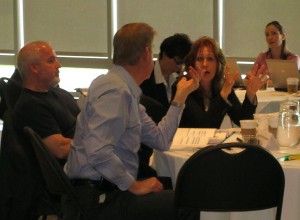 Councillor Sharman, with his back to the camera, going at it with Councillor Meed Ward at a 2011 Strategic Plan meeting. He was a different council member in those days. “Certainly, we are aware that pension income does not increase at the same pace as either inflation or the overall architecture of city finances. The city is driven by long term fiscal sustainability objectives. That discussion is not over yet, but we are trying to figure it out.
“I would suggest that we fully “get it”. I will be pleased to discuss the situation with you at any time.”
How much confidence do you want to take from those statements?
What is perplexing and at the same time interesting is that when Councillor Sharman was involved in budget deliberations in his first budget meeting during his first term of office he drove the budget increase down to 0%.
He was merciless. There were a couple of general managers at the time who were incensed with his approach – Sharman couldn’t have cared less. He wanted a 0% increase and he kept pushing until he go it.
That Councillor Sharman seems to have morphed into a different person.

 By Tom Muir By Tom Muir
January 19th, 2017
BURLINGTON, ON
Part 4 of a series:
Tom Muir, an Aldershot resident, has been an active participant in civic affairs or more than 25 years. He has been described as “acerbic”, a fair term for Tom.
He has outlined, in considerable length, a large part of why the parents at Central and Pearson high schools are in the mess they are in as a result of the recommendation to close their schools. In this article, one of a series Muir suggest what he feels are obvious solutions to the problem the Board of Education believes it has. There is a lot of material; it gets dense at times. Living in a democracy means you have to accept the responsibility of citizenship and stay informed.
I have set out what I think is the background reason for the situation Burlington parents and their high school level students face with the possible closing of two high schools in the city and I have suggeted that the mess we asre in is one we created for ourselves.
How do we get out of the mess?
Where does the Board staff appear to sit?
The Board seems to be into closing schools. Almost all the options close schools. Some seem nonsensical. I was surprised by this very limited plan.
They say 1800 empty seats is not sustainable long term. And the Board staff data is said to be accurate now, and and has been accurate in the past.
Go back to the Board data for 2010 when there were 495 actual empty seats, and 92% space utilization, in the 6 then existing schools in Burlington.
They developed plans, with no evident justification, to build another school in Alton – add 1200 seats plus about 280 in portables.
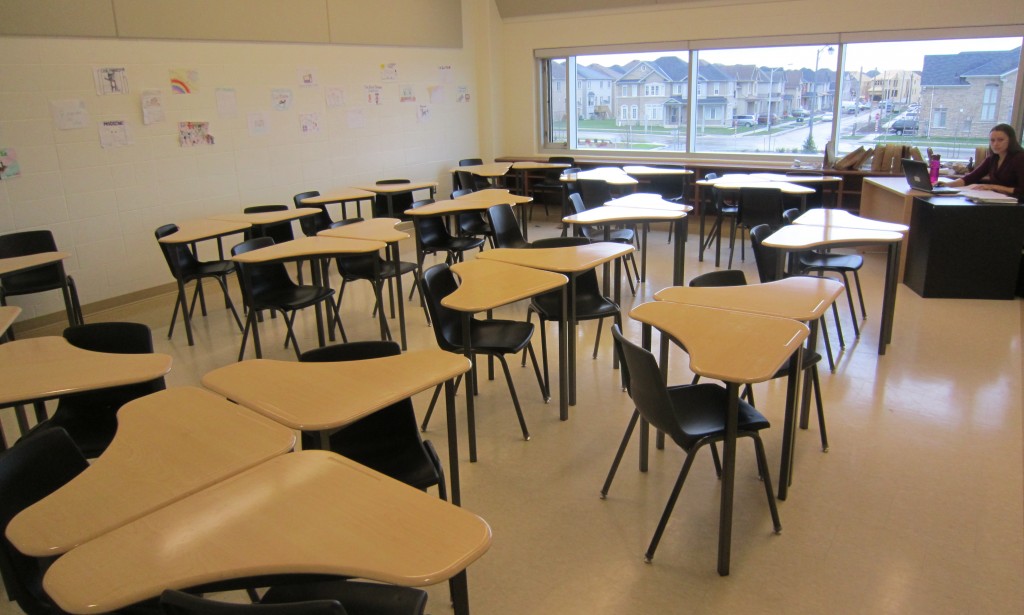 Empty classroom seats. Burlington has 1800 of them. These seat are in Hayden high school which some feel should not have been built. The recreation centre and the library made sense – the facts suggest the building of a high school in Alton created the problem that exists now south of the QEW. Build school, open in 2013, fill with about 1400 students by 2017, mostly from schools within the six existing high schools. These 1400 now become empty seats in the south Burlington six high schools.
This adds up to about the 1800-1900 now cited as unsustainable.
This is based on the past and forecast data that is said to be accurate.
So it can be said with accuracy that the Board created the 1800 empty seats that they now say are not sustainable. Why and how?
Building Hayden in Alton can be said with accuracy to be a blundered construction of most of the 1800 empty seats.
So they now want to close two schools of the original six that housed all these students, before Hayden, within the comfortable 90% utilization.
So the Board itself created this so-called unsustainable 1800 empty seats, and they did it with accuracy.
They have also gotten away with this unexplained blunder with no accountability for what is incompetent planning in my opinion, based on the face of the so-called accurate data.
 Director of Education Stuart Miller during an on-line Q&A which some parents thought was rigged. So how does this work that the Director isn’t sure now what the residents/public of the south Burlington six expect from him and the Board?
Well, what I expect is that the Director offer innovative and management solutions to clean up the mess you have created.
And don’t tell us that your forecast data are accurate. It’s seems to be a new age for housing costs and form, so families will likely have to more and more occupy higher density.
The historical pupil yield curves used may be too low in this new age. That’s what happened in the Alton community, and the Board data didn’t catch it.
Don’t make more mistakes and cost the community dearly by closing schools based on methods and attitudes that actually created the mess.
It is possible to use the toolbox to keep all the schools open. Go to that toolbox and show us how we can make the empty spaces of use.
Don’t impatiently make irreversible quick decisions that we will all have to live with in regret.
That’s what people expect, among other things, I think.
What about the efficiency and sustainability of 1800 empty seats?
But if we accept that 1800 empty seats are not sustainable, at face value, what does it imply about the strictly business end of producing student spaces?
In 2012 the utilization of SRA 100 Burlington spaces was 87%, so there was a minimal excess over the Board target of 90%. It was also projected to fall and is now at about 75%. But it only fell because Hayden was opened and students were transferred there, and this continues to date, filling up portables and a projected student surplus of about 600.
What the hell is going on here may I ask, with the Board sense of planning? And this just looks to continue in this PAR.
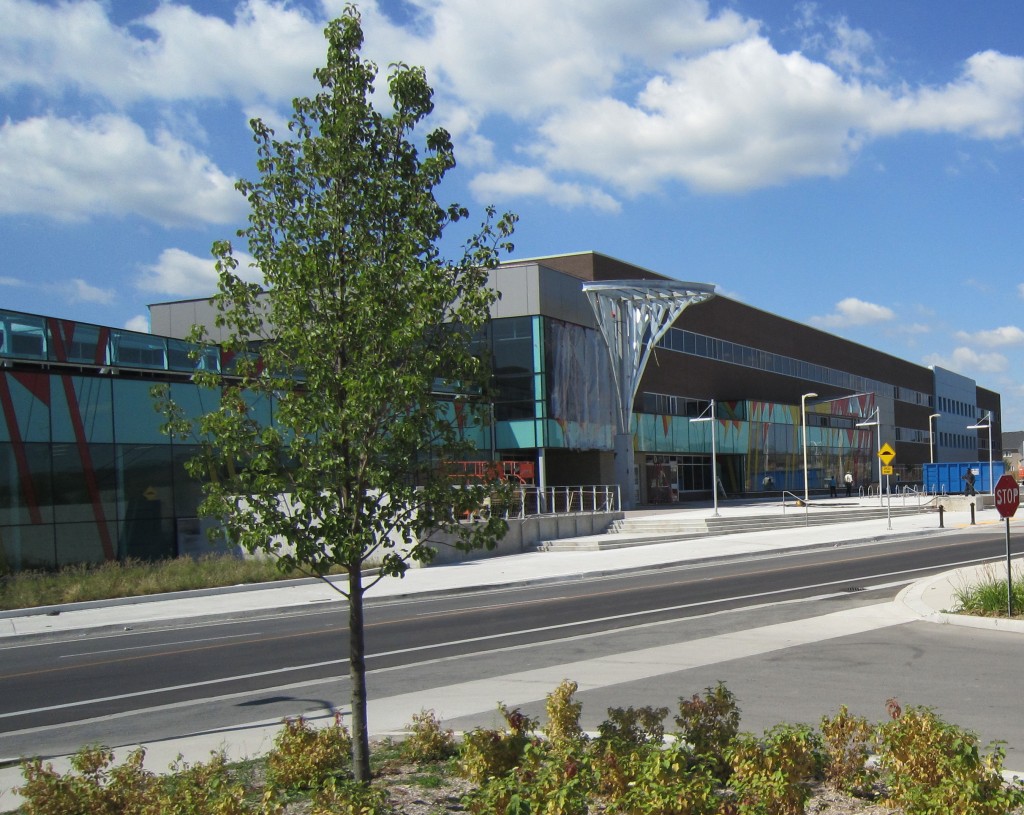 Was Hayden high school needed? Depends on what you wanted. The high school seats may not have been needed but the Board of Education, the Library and the city’s recreation department had skin in the game. The idea was to create a structure that would become a community centre and when that was decided upon – an excess of students seats got forgotten – the bureaucrats were building and if that meant the death of two high schools so be it. Where were the trustees at the time? Did they not see this coming and did they not ask questions? The point being for our business model, is that there is no apparent rationale, no business case, to build Hayden, as there was no shortage of supply of student places. There was already some identifiable surplus.
With such an excess supply identified, and projected to worsen, on the basis of this issue definition, what reason existed to build additional supply of students spaces at Hayden? In fact, we still don’t need Hayden on this basis.
If most people made this kind of business decision, they would be in deep doo-doo, and in deeper when there are serious consequences, which there are, but not for those who made the decisions.
This decision by the Board had no justifying business case in terms of student spaces, but created an excess which is now being used to justify closing schools to make up for their mistake.
Everyone knows this has just made things much worse and created a divisive mess for which no one is being held accountable.
Regarding the provision of student opportunities as a reason for the PAR, there was never any evidence provided to show that Hayden provided any opportunities that didn’t already exist. And there is still no evidence provided that closing other schools will provide any additional opportunities that also don’t already exist.
In fact, closing schools will require that 500 to 600 additional students are provided, rather “necessitated”, the “opportunity” to ride the bus to school instead of walk, which most of the would be displaced do at present. Some opportunity this is.
Hopefully, you can see the thinness of putting the issue as just about excess student spaces. The Board itself created the excess. It didn’t exist before Hayden.
Why was Hayden built? Where’s the cost-benefit analysis of what has been created?
The only thing I have even remotely heard, is that the people in the north of Burlington, in Alton, were entitled to, or “needed” schools in their neighborhood.
Which begs the question, what about the rest of Burlington, now under the gun because of the Board building a Hayden not needed for student spaces.
And here is where the real issue mess lies, the part left out of your issue definition.
Because the students were transferred in ever greater numbers, even overflowing into portables, exceeding the Hayden built supply of places, from the existing schools, and then their feeders, thus creating the excess in those schools.
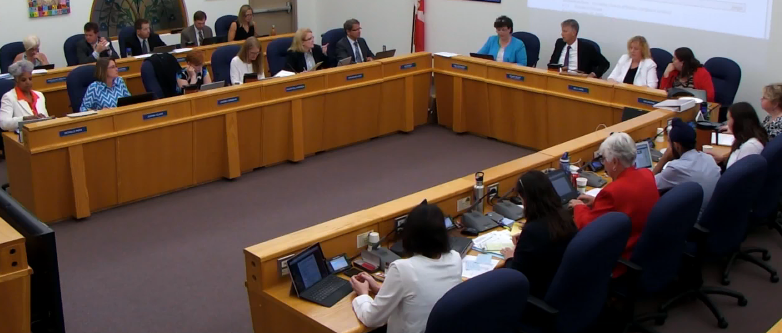 It is the trustees that are accountable. But the trustees who made the decision to build the Hayden high school aren’t there anymore. Of the 11 in office now eight are serving their first term of office. Burlington’s ward 5 trustee Amy Collard is serving her second term – both by acclamation, Trustees Kelly Amos from Burlington and trustee Donna Danielli from Milton were on the board at the time the Hayden high school decision was made. So that’s where this logic of this issue definition takes us. Based on this definition, Hayden should not have been built. Is anyone going to be held accountable for this?
If Hayden neighborhood residents and parents and students “needed” their own school, whatever happened to the rest of us down here in the south? Do we not count in this?
This is the real mess that this issue definition is too thin to manage. It is much more than excess student places, which is a red herring.
What have parents, residents and students to say about their concerns and what they want?
A perusal of the Gazette archive will get at least some sense of what some people are saying and/or want. As I noted earlier, one key thing that is missing on the accessible website are enough years of the LTAPs and reports to go back to the time that Hayden SS in Alton was being rationalized and justified. I described this situation in detail above.
So if the Trustees know that set of facts, and others do as well, what do they think resident feelings and concerns are?
 Tom Muir is a resident of Aldershot who has been a persistent critic of decisions made by city council. He turns his attention to the current school board mess. He recently suggested to Burlington city council that “If you are so tired of and frustrated by, listening to the views of the people that elected you, then maybe you have been doing this job too long and should quit. Tom Muir is a resident of Aldershot who has been a persistent critic of decisions made by city council. He turns his attention to the current school board mess. He recently suggested to Burlington city council that “If you are so tired of and frustrated by, listening to the views of the people that elected you, then maybe you have been doing this job too long and should quit.
Muir explains that the PARC will only get what people send in, what they come up with from their own efforts, and what they ask/demand from the board. They have to decide what they want and go after it ruthlessly. They will have to fight with tooth and claw and take no prisoners.
Previous articles:
Part 1
Part 2
Part 3

 By Pepper Parr By Pepper Parr
January 18th, 2017
BURLINGTON, ON
Building community happens when groups partner and create a situation when the whole is greater than the sum of the parts.
The Burlington Foundation has partnered with the Community Fund for Canada’s 150th to help make a major investment in Burlington.
 The Foundation announced a record $120,000 in Community Fund grants to be invested in 14 local projects. This represents the largest amount of Community Fund grants the Foundation has distributed in a single year since its inception in 1999. The Foundation announced a record $120,000 in Community Fund grants to be invested in 14 local projects. This represents the largest amount of Community Fund grants the Foundation has distributed in a single year since its inception in 1999.
In 2017, the Foundation’s community funds and field of interest funds are granting $60,000 and the Community Fund for Canada’s 150th is providing $60,000 in matching dollars. This initiative is made possible by the Community Fund for Canada’s 150th, a collaboration between Burlington Foundation, Community Foundations of Canada, the Government of Canada, and extraordinary leaders from coast to coast to coast.
 Ron Foxcroft, Chair of the Burlington Foundation; he gets most of them into the hoop. Foundation Board Chair and legendary community supporter Ron Foxcroft notes, “Burlington Foundation has a long history of making change happen. Our annual Community Fund grants help address Burlington’s highest priority needs, as outlined in our Vital Signs reports, as well as several field of interest focus areas. In just 18 short years, Burlington Foundation has provided more than $4.1 million in grants to charities.”
“We’re thrilled to partner with Community Foundations of Canada and the Community Fund for Canada’s 150th to help make a major investment in Burlington. Thanks to this historic collaboration, we’re bringing Burlingtonians together, fostering a greater sense of belonging and creating a lasting legacy of 2017 community initiatives for future generations,” says Colleen Mulholland, president of the Foundation. “We’re proud to help unite the generous gifts of local community members with federal funds to create a positive and lasting ripple effect across our great city.”
Burlington Foundation’s 2016-17 Community Fund Larger Grant Program is providing 14 grants ranging from $5,000 to $13,000. For example, Burlington Public Library will use the grant to support Honouring the Truth, an initiative that builds upon the Truth and Reconciliation Commission’s Calls to Action.
 Maureen Barry, CEO of the Burlington Public Library Maureen Barry, Library Chief Executive Officer notes, “Honouring the Truth celebrates Indigenous historical legacy and ceremony within Indigenous and non-Indigenous communities. Public initiatives that pay tribute to the native lands and stories of First Nations peoples will help build a deeper understanding and awareness of reconciliation as a collective, ongoing process.”
ArtHouse will use the grant to support Mending Fences, a collaborative public arts project for vulnerable youth. More than 650 local youth will help transform 40 designated sites across Halton Region into ”creative spaces”, all in vibrant celebration of Canada’s 150th. Don Pangman, ArtHouse Founder and Executive Director explains, “Mending fences will allow us to hear the voices of our youth through the arts by providing a safe place for them to express themselves and to unleash their creativity.”
 Grant to provide Ontario farm fresh food through the summer months. As well, Food4Kids Hamilton Halton, Foodland Ontario, Feeding Halton and Food for Life will collaborate and use the grant to supply 100 children living in low-income homes with Ontario farm fresh food through the summer months, ensuring access while also engaging them to grow, cook and enjoy healthy food.
Additionally, the Foundation awarded 12 grants of $500 to $2,000 in November 2016. The Foundation’s local Seed Grant Program features a simplified application process and supports smaller-scale initiatives.
About Burlington Foundation
Since 1999, individuals, agencies and corporate donors have partnered with us to make change happen. We understand the difference we make is greater when people work together. Burlington Foundation collaborates with donors to build endowments, give grants and connect leadership. We help people give brilliantly, build legacies, address vital community needs and support areas of personal interest.
About Community Fund for Canada’s 150th
The Community Fund for Canada’s 150th (CFC150) is a collaborative effort, seeded by the Government of Canada and extraordinary leaders from coast-to-coast-to-coast. The Fund is matched and delivered locally by Canada’s 191 community foundations.
CFC150 projects are building community and inspiring a deeper understanding of Canada throughout the sesquicentennial
2016-2017 Larger & Seed Community Fund Grants
 Trevor Copp of the Tottering Bipeod Theatre Acclaim Health – $2,000 (Seed Grant)
Art Gallery of Burlington – $6,500 (Larger Grant)
ArtHouse for Children and Youth – $10,000 (Larger Grant)
Burlington Baptist Church – $12,462 (Larger Grant)
Burlington Public Library – $5,000 (Larger Grant)
Calvary Baptist Church Burlington – $5,480 (Larger Grant)
CameronHelps (2006) Inc. – $6,575 (Larger Grant)
Carpenter Hospice – $2,000 (Seed Grant)
Community Living Burlington – $2,000 (Seed Grant)
Food4Kids Hamilton Halton – $13,000 (Larger Grant)
Halton Catholic Children’s Education Foundation (HCCEF) – $1,400 (Seed Grant)
Halton District School Board (Aldershot School) – $2,000 (Seed Grant)
Halton District School Board (Burlington Central High School) – $1,000 (Seed Grant)
Halton Learning Foundation – $6,000 (Larger Grant)
Holy Rosary School – $2,000 (Seed Grant)
Literacy South Halton – $1,100 (Seed Grant)
Muscular Dystrophy Canada – $2,000 (Seed Grant)
Shakespearience Performing Arts – $500 (Seed Grant)
Shifra Homes Inc. – $8,183 (Larger Grant)
St. Christopher’s Anglican Church – $13,000 (Larger Grant)
Summit Housing and Outreach Programs – $8,500 (Larger Grant)
Support & Housing – Halton – $2,000 (Seed Grant)
Symphony on the Bay (Greater Hamilton Symphony Association) – $12,500 (Larger Grant)
Tetra Society of North America – $4,800 (Larger Grant)
The Bridge From Prison to Community (Hamilton) – $2,000 (Seed Grant)
Tottering Biped Theatre – $8,000 (Larger Grant)

 By Staff By Staff
January 18th, 2017
BURLINGTON, ON
The Halton Regional Police report that from October 1st to December 31st 2016, the Halton Regional Police Service (HRPS) arrested 185 people for violent behavior. The focus on the Provincial Anti-Violence Intervention Strategy (PAVIS) is a multi-agency program run through the Ministry of Community Safety and Correctional Services.
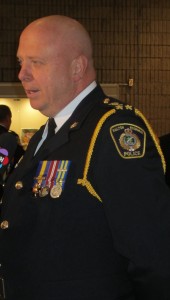 Halton Regional Police Chief Tanner This year HRPS applied principles of Community Safety and Well-Being Planning as part of PAVIS efforts. This was achieved through enforcement of violent offenders, risk intervention, crime prevention and collaboration with community partners in social development.
HRPS partnered with stakeholders to increase organizational and community capacity to prevent and address recidivism through risk-based interventions. Strategies included increasing resources during weekends and evenings, compliance checks of individuals who failed to abide by court-imposed conditions; collaboration with external partners on sentencing matters of offenders and dedicating resources to pursue arrest warrants.
As a result of the PAVIS initiative from October 1st to December 1st 2016, a total of 185 arrests were made and 243 criminal charges were laid across the Region. Emphasis was placed on proactive collaboration between the Police, Probation and Parole, the Crown Attorney’s Office and other community partners.
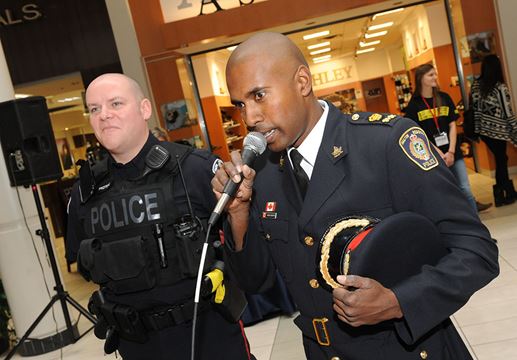 As part of a Crime Stoppers event Deputy Chief Nishan Duraiappah pleads his innocence to the charge of Grand Theft Donuts, looking on is Halton Regional Police Detective Constable Paul Proteau. Deputy Chief Nishan Duraiappah takes a positive view: “Repeat offenders, high risk individuals and those bound by court orders have an opportunity to change their behaviour and lives. Unfortunately, in some instances these individuals pose a continued risk to community safety. Police enforcement in conjunction with emergency response, risk intervention, prevention and social development has made this unique initiative a success.”
PAVIS initiatives in the area of Emergency Response included officers responding to calls for service involving known violent offenders in our community. PAVIS related patrols were strategically deployed throughout the Region. Officers were able to safely engage and diffuse potentially violent situations. Numerous offenders were arrested prior to or during the commission of a criminal offence.
PAVIS initiatives in the area of Risk Intervention involved specific follow-up with recidivists who were actively breaching court imposed conditions. In many cases this resulted in arrests and charges being laid, but also the recovery of stolen property, weapons, illegal drugs and other prohibited items. Halton Police also collaborated with other police agencies to arrest recidivists who were breaching their probation outside of Halton Region.
Individuals were apprehended at Pearson International Airport as well as in other jurisdictions. Criminal Code search warrants were executed in Nova Scotia and New Brunswick, with the accused being returned to Ontario. An exchange program between the Montreal Police and the HRPS was developed, which facilitated in locating 19 offenders (10 in Ontario and 9 in Montreal).
 Police trying to apprehend a violent offender. Prevention and Social Development initiatives focused heavily on the collaboration between Probation and Parole and the Crown Attorney’s Office to review new offenders in the Region and develop strategies to address recidivism from the time an offender is released into the community. Proactive checks were conducted to ensure compliance with court imposed conditions.
A Post-Conviction Sentencing Committee was formed between HRPS, Probation and the Crown to improve communication in regards to conditions placed on offenders during sentencing. A community services guide was provided to every prisoner in HRPS custody prior to their release.
A database has been created to identify wanted individuals and those on street enforceable conditions, to be made available to officers after the PAVIS funding has concluded. Officers also developed a resource guide to be distributed to parents or guardians of young persons in conflict with the law.
The Project was been made possible by a grant from the Ministry of Community Safety and Correctional Services.

 By Tom Muir By Tom Muir
January 18th, 2017
BURLINGTON, ON
Part 3 of a series:
Tom Muir, an Aldershot resident, has been an active participant in civic affairs or more than 25 years. He has been described as “acerbic”, a fair term for Tom.
He has outlined, in considerable length, a large part of why the parents at Central and Pearson high schools are in the mess they are in as a result of the recommendation to close their schools. In this article, one of a series Muir suggest what he feels are obvious solutions to the problem the Board of Education believes it has. There is a lot of material; it gets dense at times. Living in a democracy means you have to accept the responsibility of citizenship and stay informed.
The Board of Education advised its trustees that there were 1800 empty seats in Burlington’s seven high schools. The Director of Education, Stuart Miller, brought forward a number of recommendations. The trustees decided to create a Program Accommodation Review Committee (PARC). That committee will begin its meeting later this month.
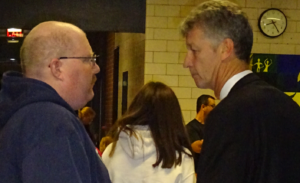 Director of Education Stuart Miller, on the right engaging a parent at Central high school. The PARC will review the data – there is tonnes of it, and send a recommendation to the Director of Education who will then make his recommendation to the trustees who will make a final decision as to whether or not any high schools should be closed. The schedule calls for this to be done by May of this year.
Other ideas are suggested by residents in the on-line conversations in the Gazette. There are other more inclusive lists of such ideas elsewhere. Surely, the Board staff and consultants, and education researchers, have a cornucopia of ideas that just need to be unleashed. As Rudyard Kipling said, “there are 99 and 9 ways to make tribal lays.”
This, I think, is a way to go to get to a plan fitting with the times, changing demographics and adaptability to such changes, fairness, and the patterns of the Growth Plan for Halton.
 A new community was created when Hwy 407 was built. The Alton Village underwent significant growth requiring public and high schools. Some are not sure the high school was such a good idea.. It is just not right that existing residents are required to give up their schools, in order to build new schools in areas where the high growth in population is being directed under the force of the provinces’ orders in the Growth Plan.
Why should this be a forced confiscation in service of the province’s growth orders? Why should we pay for another part of the growth with our schools?
As I said, things are being taken too far in this insensitive and unlimited logic of efficiency, narrowly defined, leading to fewer and fewer schools in existing neighborhoods.
Once these school sites are gone, they are gone – there are no other places to site new schools. What kind of municipal and community planning is that?
And for those seeming to be okay with the closure of two high schools, as inefficient, and needing to be eliminated, I have to ask if they have ever considered what might be the limits of their criterion or their logic?
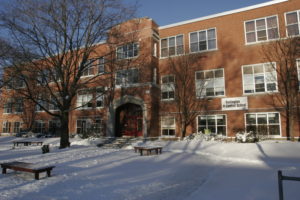 Burlington Central high school – the oldest in the city located in a neighborhood with intense loyalty to the place. There are some fourth generation students at the high school. Do they propose to applaud this process year after year until “most efficient” and “biggest” become synonymous with “only”?
Do these schools have any value not subsumed under the heading of “efficiency”? And who benefits by their closure?
Is “any” degree of “efficiency” worth any cost in our schools?
Can progressively closing more and more schools be treated with such regardlessness, by merely asserting a justification that leaves out all the cultural and community values that they embody?
The point being that there must be limits imposed to this process before our cultural institutions of education have been corrupted to calamity.
This process is leading to no good, and is rotten politics.
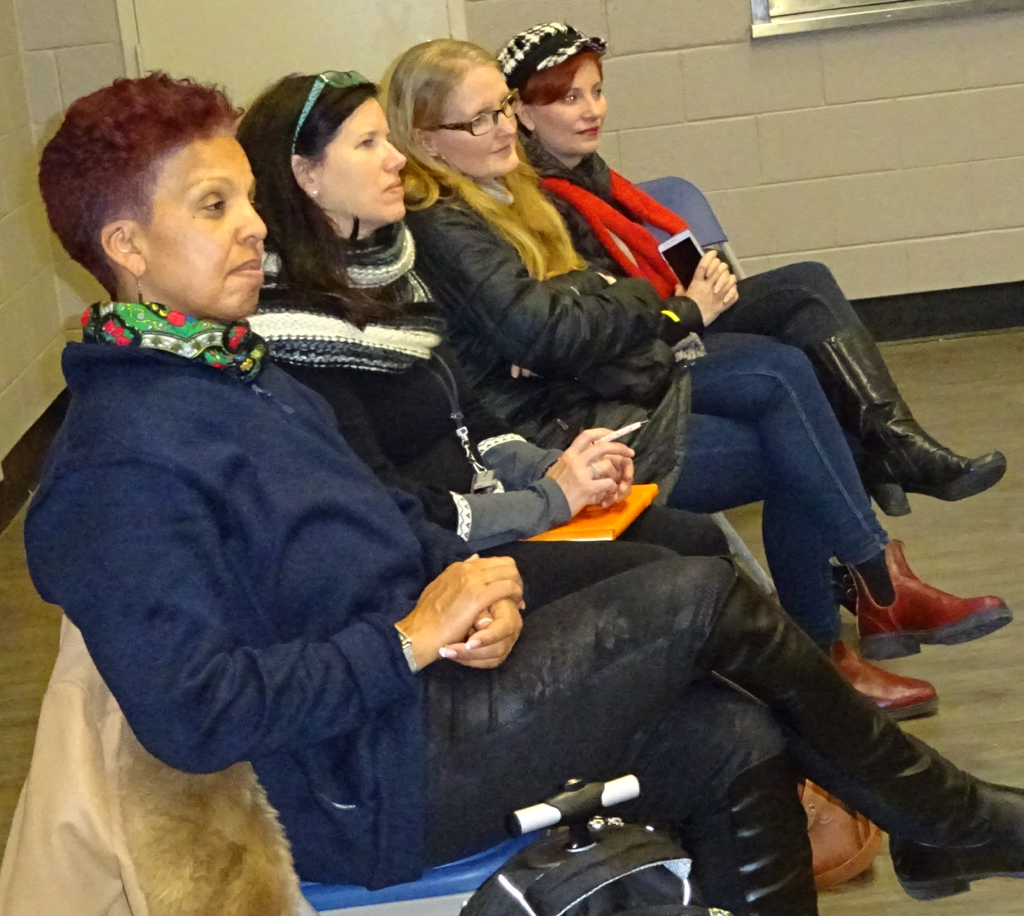 Halton District School Board trustees sit at the back of the room during a December public meeting. From the left: Papin, Reynolds, Ehl Harrinson and Grebenc. Some things the Trustees can do.
Hayden has 500 to 600 pupils too many in the LTAP forecast. The Board moved 600 to 900 from the area of concern, such as Pearson, Nelson, Bateman, and Robinson. You can see this in the capacity utilization rates in the Board reports and reproduced in the Gazette.
They can simply move some number like the 600 back, as they have the power to do that, just like before, when they moved them out. We need to know what the numbers by school were that were moved to Hayden.
They can even shuffle students from Hayden around the Board SRA 100, which is also in the plan but only at a low scale. Shifting students and programs around all of Burlington, including SRA 100, can be considered.
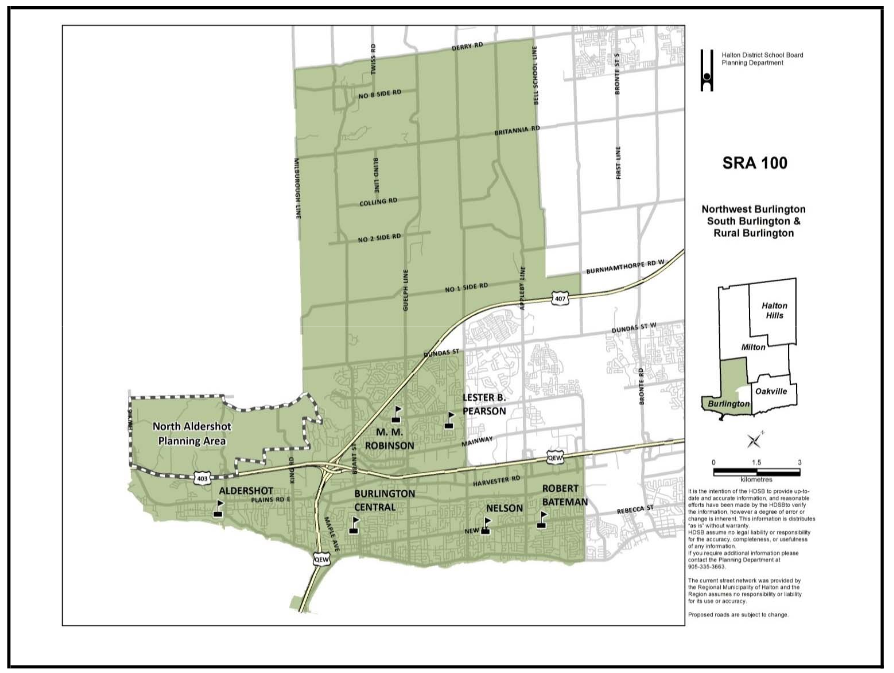 Secondary Review Area where all the high school are concentrated. Closing portables and using the bricks and mortar OTG capacity for students fits into using excess spaces, and is something that parents and students have expressed the desire to see. It will certainly be better for students.
Closing the 2 schools mentioned is reported to mean almost 600 more students from them need to be bused, increasing the number from 1000 to 1600.
So no closures, and moving students from Hayden back to the other schools – some of which is in the Option 19 for French Immersion at least – is a perfectly logical thing to do.
It will also save significant busing dollars (not specified in the reports I saw), that won’t need to be added to the already $15 million transportation bill of the Board as a whole, and will avoid big disruptions to students lives.
At least one or two SRA 100 schools are close enough that busing of students is not needed.
Again, shuffling the excess around, and changing the catchments accordingly are all possible and will facilitate the adjustments.
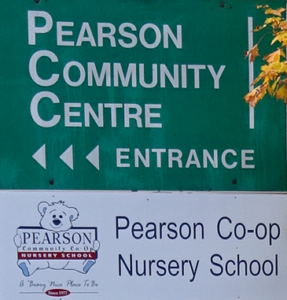 The Lester B. Pearson high school was “purpose built” with an extra gymnasium and a Day Care Centre. The Halton Board has many programs scattered around, and these can be expanded perhaps by shifting some to schools with surplus space.
The Community Partnerships and Hubs outreach, partly funded and touted by the Province on their website as involving schools, can be tapped to expand uses of space.
The existing daycare at Pearson is exactly what the province mentions as one of the possibilities. What happens to that with a closure of Pearson and Central?
Where are these options in the plan? These things are obvious solutions.
I’m confident that the PARC members also have a great number of ideas, and they are much more intimate with the schools and what they want than I am.
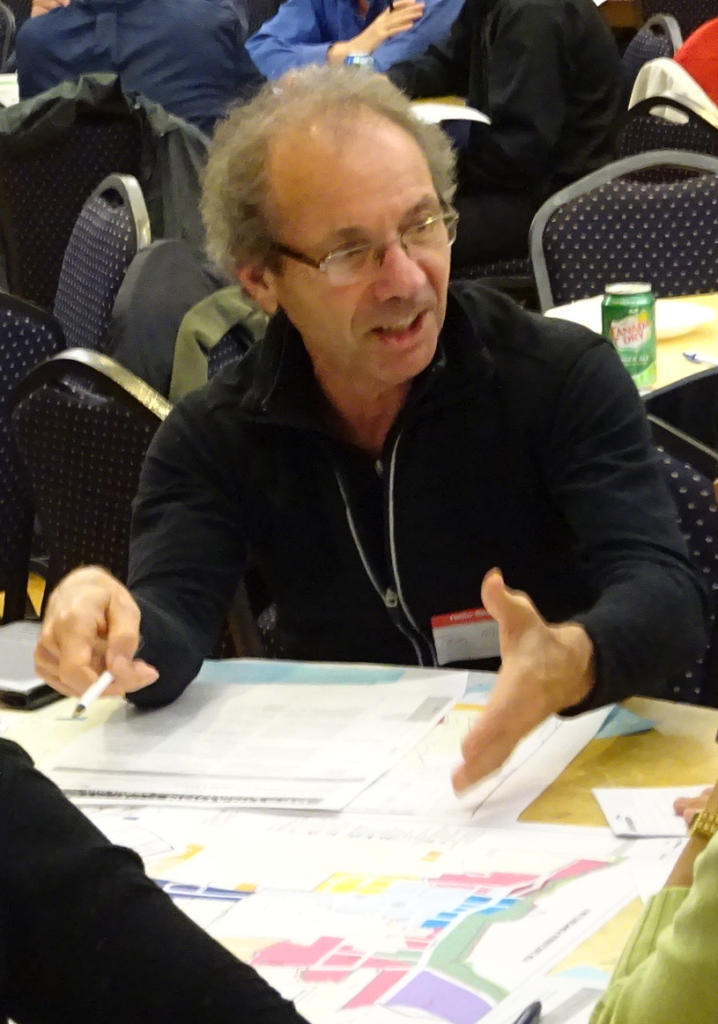 Tom Muir; an acerbic community advocate. Tom Muir is a resident of Aldershot who has been a persistent critic of decisions made by city council. He turns his attention to the current school board mess. He recently suggested to Burlington city council that “If you are so tired of and frustrated by, listening to the views of the people that elected you, then maybe you have been doing this job too long and should quit.
Muir explains that the PARC will only get what people send in, what they come up with from their own efforts, and what they ask/demand from the board. They have to decide what they want and go after it ruthlessly. They will have to fight with tooth and claw and take no prisoners.
Previous articles in this series:
Part 1
Part 2

 By Staff By Staff
January 17th, 2017
BURLINGTON, ON
These thieves apparently thought there was going to be all kinds of snow.
On December 11th 2016 between 9:15 PM and 9:29 PM, an unknown culprit stole a pickup truck with an attached trailer that contained three snowmobiles from a business on Industrial Street in Burlington.
 On January 12th 2017, members of the Burlington Criminal Investigations Bureau – Commercial Crime Team executed a search warrant at an address on Twenty Road East in Hamilton where the stolen trailer and two of the snowmobiles were recovered and one male arrested for possession of property obtained by crime. The value of the recovered property is approximately $15,000.00. On January 12th 2017, members of the Burlington Criminal Investigations Bureau – Commercial Crime Team executed a search warrant at an address on Twenty Road East in Hamilton where the stolen trailer and two of the snowmobiles were recovered and one male arrested for possession of property obtained by crime. The value of the recovered property is approximately $15,000.00.
Police are still looking for a dark blue 2002 GMC Sierra pick-up truck with Ontario licence plates 8608KY and a red 2007 Yamaha RST snowmobile with Ontario licence plate 985115
Scott David BOYD (48-yrs) of Hamilton was charged with possession of property obtained by crime over $5000. He was released on a Promise to Appear in Milton Court of February 15th 2017.
Investigators are seeking information that will lead them to the remaining stolen property and the persons responsible for the theft.
Anyone with information is asked to call D/Cst. Colin MacLeod of the Burlington Criminal Investigations Bureau at 905-825-4747 ext. 2357 or Crime Stoppers “See something, Hear something, Say something” at 1-800-222-8477(TIPS) or through the internet at www.haltoncrimestoppers.com or by texting “Tip201” with your message to 274637 (CRIMES)

 By Tom Muir By Tom Muir
January 17th, 2017
BURLINGTON, ON
Tom Muir, an Aldershot resident, has been an active participant in civic affairs. Our colleague, Joan Little described Muir as “acerbic”, a fair term for Tom.
He has outlined, in considerable length, a large part of why the parents at Central and Pearson high schools are in the mess they are in as a result of the recommendation to close their schools. There is a lot of material; it gets dense at times. Living in a democracy mans you have to accept the responsibility of citizenship and stay informed. This is a multi part story.
The Board keeps repeating the phrase – “we have too many empty seat” and that is true.
If you are asking the question “whodunnit” to us, the answer is, “the Board dunnit”. They created this awful mess and our trustees have just been sleepy collaborators in this doing.
And the Board just lets this pass by the trustees with no emphatic warning to parents, residents and city Council, of what was coming?
In my opinion, no one was in charge to see this coming and head it off, or at least give a lot of early warning, underlined and publicized.
 A message that might have been a little on the late side. Why you would build a new school, with projected enrollment of 1600, when the surplus of available places in the existing schools were projected to increase to 2500, and nobody says anything about this disconnection, is beyond me. Or anyone else I know who has talked about the problem, and how the Board operates.
Where is this problem going, and where might it go?
I can tell, more broadly from my study of this, that there is a lot more of this issue still underwater, and coming, but it’s understated there in the LTAP reports.
Burlington SRA 100 catchments (which can be changed, and were changed for Hayden) are in mature communities, and with the transfers to Hayden, are not projected to grow enough students to fill schools built in another era. This Burlington area is also not taking on the endless high growth of other parts of Halton.
There are new high, and elementary, schools in the pipe for this growth and the Board will be sooner or later coming for more closures to get the available place capacity down to some level to get grants for the new schools for the growth. But these new schools will be put somewhere else.
This will only cause more trouble in the future, and the suggested closures at present foretell more in the future. The elementary schools are linked, and next for PARs – stated in the current LTAP – and will be domino-ed if there are closures.
My general impression is that new schools are planned for, and built in the growth areas when grants are available. If there is too much excess students spaces elsewhere, the Board goes there, does a PAR, and takes back – closes – schools in areas with available spaces, which are in the elsewhere.
That’s like what’s being done here now, but parents and residents aren’t really being told about that part. But hints are in the LTAP reports.
 Was Hayden high school needed? Was there a business case for the construction of the school. When originally planned it grew from a high school – that had a public library and a Recreation Centre added to it. There came a point when it all looked just too good. And the growing Alton community needed a high school. There seems to be no limit to this, just the timing. It’s outrageous, and a rip-off, as we paid for the schools in the first place, and now have to pay twice for new ones – the province funds new schools with our money, then takes back some old schools, so we pay again, but with an added insult.
This is what I fought back in 1998-2000. This time, it has been hidden. You see it coming in the LTAPs, but it’s subtle.
What can Trustees do?
The Trustees of course work within the provincial rule book, but they definitely DO NOT have to choose to close schools.
 Of the 19 options – this is the one the Board of Education staff recommended. Why? They have a tool kit that they can pick and choose from so as to spread the student numbers around, together with the dollars, and innovate to keep the schools open.
However, the Board staff has chosen to make pretty much all the options presented as mostly about closures. As far as I’m concerned this is the bureaucrat in them defending their past decisions that led to this messy situation.
The Trustees have the authority to change this, and to give the Board marching orders to come up with another plan that uses all of the tool kit.
 Will the 11 school board trustees hang together as a group and really think the issue through or will they leave it to the Program Accommodation Review Committee to come up with an answer they can live with. One problem that is foreseeable is that the Trustees are played off against each other depending on the part of Halton they represent. Milton is projected to grow a great deal in population, and Oakville is next in numbers.
Milton and Oakville each have 2 elementary schools in the planning pipe for 2018 to 2021, and these are not yet funded. Each also has a high school in the planning pipe for the 2019 to 2021 period and these are not yet funded either.
These proposed schools are all for students and parents that are not even born yet, but are projected from the future growth driven by provincial orders.
This is the rub. Will the Milton and Oakville Trustees put these possible future students that are not even here yet, before existing students, already living here but in schools somewhere else – in Burlington?
Will these trustees turn against their colleagues and neighbors and vote to close their schools, so they can have some new ones for people who aren’t here yet?
People who obviously do not vote here yet, and certainly didn’t elect any of the Trustees.
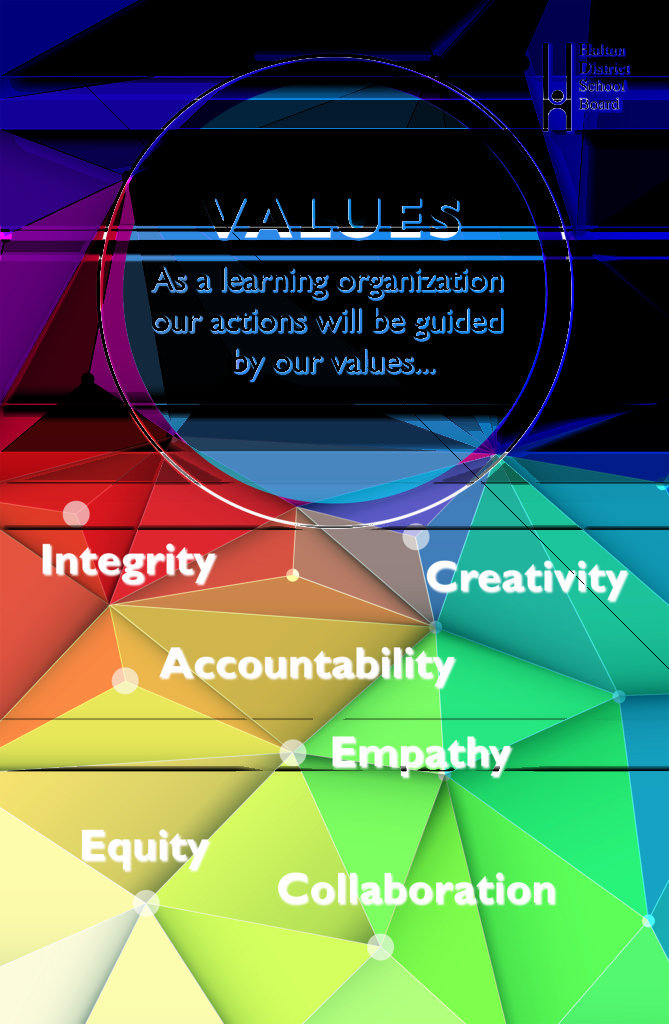 This large poster hangs on the wall of the school board meeting room The Trustees don’t have to vote that way, but who knows? People are strange.
However, they do have the power to unite and stick together. They can put together better ideas, and order the Board staff to make another plan that keeps schools open.
This will be a testing time for these trustees. Burlington Central high school is putting up quit a fight – they raised $14,000 at a Silent Auction. These people are not going to go quietly into the night.
Such a plan may contain innovative elements – which just happens to be in the latest Board Multi Year Plan goal to use innovative approaches to using learning spaces.
Part 1 of a multiple part series

 By Pepper Parr By Pepper Parr
January 17th, 2017
BURLINGTON, ON
While city council works through the operational budget for 2017 – they will be doing the heavy lifting on Thursday and settle on what the taxes will be at a city council meeting on the 23rd.
The Finance department has done all its prep work – it is now in the hands of city council
Director of Finance Joan Ford did say that while the proposed tax increase is above the 4% level – they have managed to whittle away more than $1 million on the spending side.
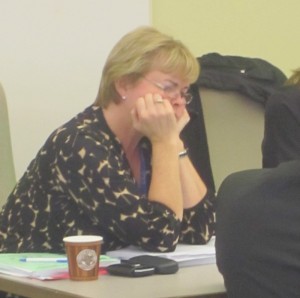 Joan Ford, the city’s Director of Finance knows where every dollar comes from and where every dollar gets spent. The struggle for the city is upgrading the infrastructure which needs millions more. This is the result of tax increases that were at the 0% level during the late 90’s. Ford pointed out that if tax increases had been as little as 1% a year for those ten years the city would not be in the uncomfortable situation it is in today.
When the province told the city that it was going to have to come up with $60 million to pay for part of the hospital renovation/redevelopment program and that the hospital foundation would also have to come up with an additional $60 million a special levy was placed on the tax bill.
That levy was supposed to end in 2019 but it has been “repositioned” infrastructure. City council, on the advice of the finance department decided that they would just change the original reason for a tax – give it a new name and continue to collect the money.
There was never an explanation. That one has election issue potential written all over it.
A decision made in November of 2012 approved Long Term Financial Plan which included the following key strategic objectives for the city:
1. Competitive Property Taxes
2. Responsible Debt Management
3. Improved Reserves and Reserve Funds
4. Predictable Infrastructure Investment
5. Recognized Value for Services
The Director of Finance presented a 2017–2036 operating forecast. It is not a pretty picture through to 2019 – after that is gets digestible.
 The purple line is the one that matters. It represents spending the city does. The bar chart is the tax increase when you add in the school tax, which the city has no impact on and the Region budget which we are part of but we don’t make that decision – we do influence it. The forecast is based on estimated budget drivers using the 2017 budget numbers as a starting point.
Ford pointed out that the simulation forecast has greatest precision in the first year and added that it is imperative that the results are simply used as an information tool regarding major budget drivers and future projected tax impacts.
Not only does it provide an analysis of what the future financial picture for the City of Burlington might look like, but it also helps assess financial risks and the affordability of existing and new services, existing and future capital investments, as well as provides an opportunity to analyze sensitivities to assumptions.
Looking into the future means considering:
• Changes in economic conditions and market demands
• Fluctuations in customer expectations
• Legislative changes
• Reassessment impacts
• Operating impacts from approved capital initiatives
• Joint venture and other business agreements
• Business process improvements
Assessment growth has been a bug bear for the finance department. Expecting assessment growth of 1.6% was projected for one year – it came in at 0.15%.
Staff have shown a realistic scenario where assessment growth is maintained at 0.6% per annum; no new legacy projects are forecasted; and infrastructure renewal funding is addressed over the 20-year time horizon, as per the Asset Management Financing Plan. These components provided the basis for estimating budget drivers and include the following assumptions within each item:
Maintaining Current Service Levels – Base Budget
Inflationary Impacts and User Fees
• With the exception of human resources and commodities (hydro, water, fuel etc.), 2.0% inflation per year has been applied to all other expense categories (materials and supplies, purchased services and contributions to local boards and committees)
 Taxpayers would prefer a different % in that tax increase. • The increases to User Rates and Fees assumed a 2.0% increase per annum, which is dependent on the nature of the revenues and external market conditions
• An annual increase of 3% to the Vehicle Depreciation Reserve Fund to sustain the City’s fleet and equipment inventory
Corporate Expenditures/Revenues
• An annual increase to the provisions for Insurance and Contingency Reserves of $100,000 each.
• An increase in Investment Income of $100,000 per year in 2019 and beyond given the current low interest rate environment.
• Reversal of one-time revenue of $220,000 for assessment growth stabilization in 2018.
Other Expenditures
Infrastructure Renewal Funding and Joseph Brant Hospital
• An annual increase of 1.25% for Dedicated Infrastructure Renewal Funding from 2017-2022, reduced to 1.0% for 2023-2033 and 0.5% for 2034 and 2036. This provides funding for capital renewal, as per the Asset Management Financing Plan (approved 20-year scenario).
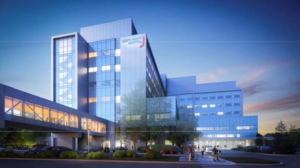 That special tax levy for the hospital is apparently with us forever – money will go into infrastructure starting in 2019. • An annual increase of $200,000 (2020-2024) in order to phase in required increase for debt charges.
• Includes the repositioning of the hospital levy to infrastructure renewal in 2019 ($1.5 million), 2026 ($800,000) and 2027 ($2.5 million)
Business Cases
• Details from the 2017 Capital Budget and Forecast as well as growth related operating impacts in the future
• In order to address Service enhancements, similar to the one included in the 2017 Proposed Budget for Tree Service ($254K), $600,000 have been included in the 2018 Forecast for Playfield Service levels, reducing to $400,000 annually from 2019 and beyond for other Service enhancements.
Allowance for Unknown Factors
As with all forecasts, it is imperative to recognize that there are a vast number of unknown factors that will likely occur in the future that could impact the model. In order to address these unpredictable factors, an amount of $100,000 has been included in the 2019 forecast, increasing by $50,000 per year until 2027, and maintained at $500,000 beyond that.
Assessment Growth
The weighted assessment growth for the 2017 budget is 0.15%. Assessment growth is estimated to be 0.6% in 2018 and maintained unchanged for the remainder of the 20- years. Over the last 5 years, weighted assessment growth has ranged from a low of 0.15% to 1.16%. The five year average is 0.75%.
The proposed 2017 Budget reflects a city tax impact of 4.23%.
 An increase for 2017, which is greater than the increase in 2016, which was greater – you’re getting the picture aren’t you? The simulation forecasts the city tax impact from 2018 to 2036 to begin at 4.96% reducing to 2.90%.
While staff will look for ways to smooth out the timing of operating impact from prior approved capital projects, it is important for council to recognize the significant pressures in 2018. One way to stabilize significant spikes would be to partially advance a known 2018 budget pressure. While this would increase the 2017 budget, it could assist in mitigating the 2018 forecasted impact.
Keep in mind that 2018 is an election year; some of the members of council might want to get re-elected.
Councillors Taylor and Dennison were on council when those 0% tax increases were boasted about. They might choose to take their pensions and move on before the proverbial hits the fan.
There is a young candidate with significant potential looking closely at Taylor’s ward 3 seat.

 By Tom Muir By Tom Muir
January 16th, 2017
BURLINGTON, ON
Tom Muir, an Aldershot resident, has been an active participant in civic affairs. Our colleague, Joan Little described Muir as “acerbic”, a fair term for Tom.
He has outlined, in considerable length, a large part of why the parents at Central and Pearson high schools are in the mess they are in as a result of the recommendation to close their schools.
There is a lot of material; it gets dense at times. Living in a democracy mans you have to accept the responsibility of citizenship and stay informed. This is a multi part story.
1. How was this problem created and why is it a mess?
Everyone needs to appreciate that there is a lot of Long Term Accommodation Plans (LTAP) and other reports and information on the Board website, but knowing how to find them, and have the time to read and comprehend it all, are daunting for people not used to this kind of analysis. And if they have both jobs along with their kids and home responsibilities, this just gets much worse.
The Board writes these long LTAP reports but the trustees I think seem to be snowed under by them, over time. There are plenty of warnings and facts presented about what is going on, but somehow it doesn’t fizz on them, and parents and residents are not given any warning of what lies ahead on the path the Board is on. That’s the case I found here, and it’s not hard to find if you know how to look and take the time.
One thing that is missing on the accessible website are enough years of the LTAPs and reports to go back to the time that Hayden SS in Alton was being rationalized and justified and a new SRA 101 was created..
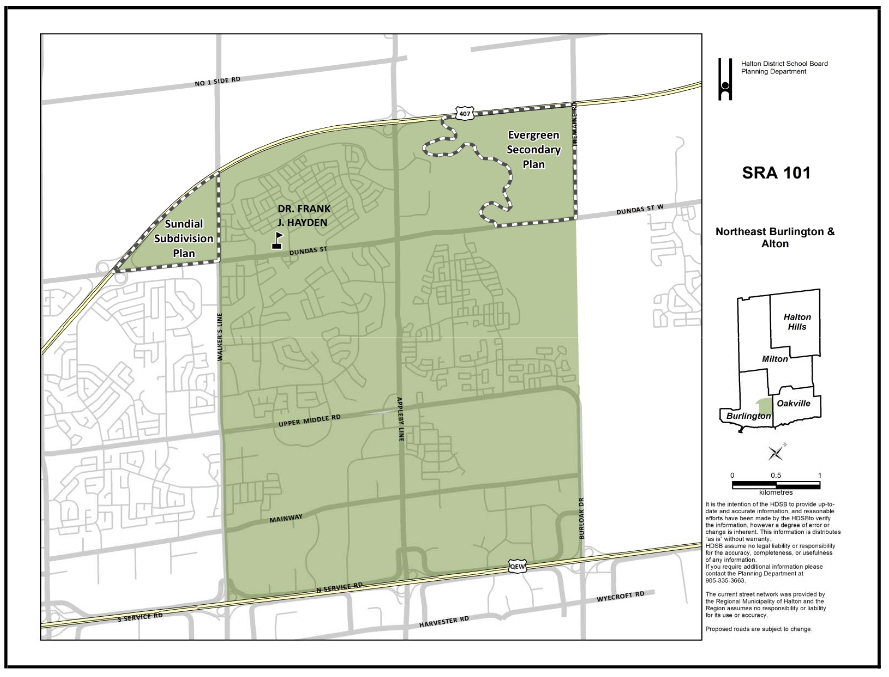 This Secondary Review Area contains one school. Dr. Frank J. Hayden SS opened with grades 9 and 10 in September 2013, and grew one grade each year. Enrolment currently exceeds OTG capacity, resulting in the placement of 6 portables on site. A high percentage (30%+) of grade 8 students from Orchard Park PS and Alexander’s PS enrolled in a secondary school other than Dr. Frank Hayden SS in 2015. More than 90% of grade eight students from the following elementary schools attend Dr. Frank J. Hayden SS: Charles R. Beaudoin PS FI program, John William Boich PS FI program Alton Village PS Dr. Frank J. Hayden SS is projected to be over-utilized. Enrolment is approaching Total Capacity by 2016. Boundaries may need to be re-evaluated as part of a future Program and Accommodation Review. To Be Determined Area, students are projected in this area within the next five years. Consideration should be given to establishing school catchments for this area as development approvals move forward. Data is avalable for as far back as 2010-2011 where toy can already see the troubles looming. But there is no hint of how Hayden was justified on pupil place needs – there weren’t any – when it was already known that building the school would drain all the students from the existing high schools and create large and growing surplus places there, while overfilling Hayden, even with Portables, right from the start.
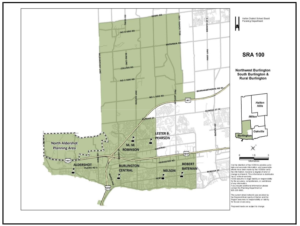 Secondary Review area 100 shows the high schools south of the QEW where the population was concentrated. The creation of the Halton community when the 407 highway was built suggested the need for an additional high school. For example, in 2010-2011 LTAP report, we see the following.
The Board data for 2010 indicates there were 495 actual empty seats, and 92% space utilization, in the 6 then existing schools in Burlington. There was obviously no problem with surplus places and the trends stayed in a 90 to 80% bracket to 2020.
With the projected opening of the Alton school, the transfer of students from the other schools to the Alton school began, and the steep increase in available places in the existing 6 Burlington schools began.
From the 2010-2011 LTAP commentary:
– New subdivision development in SRA 101 contributes to the high utilization of Lester B. Pearson H.S., M.M. Robinson H.S., Nelson H.S. and Robert Bateman HS
– Opening of the proposed Alton community high school (2011) will cause enrollment to drop in most schools.
– A boundary review for the proposed Alton community high school has been initiated.
– There is potential for a PARC (Program and Accommodation Review Committee) Process to be initiated.
The plans were to build another school in Alton – add 1200 seats plus about 280 in portables.
The Board set out to build the new high school and decided to make it both a public library, a recreation centre and a high school and opened it in 2013 (at first it was 2011/2012), filled it with about 1400 students by 2017 from schools within the six existing high schools. These 1400 now become empty seats in the south Burlington six schools.
Together with the 495 cited above, this adds up to about the 1800-1900 empty seats now cited as unsustainable.
So this was basically already known before 2010, but the possible consequences were never made public or explained to anyone, from all appearances.
As well, in this 2010-2011 LTAP, there is no business case, or any other rationalization, based on a deficit in pupil places, for building a new school in Alton. This may have been done in earlier years, but there is no visible evidence of the need anywhere, and it is not available or provided for public information right now.
This rationale needs to be provided.
2. How did we stay on this path to problems?
The path Burlington was put on by these Board decisions continued unabated, but the consequences continued to be unexplained to the public, and seemingly were not appreciated or were ignored by Trustees.
I went back to the LTAP for 2012-2013. It quite clearly states that opening Hayden was going to cause problems.
Here’s something I copied out of that report (my underlining). SRA 100 contains the 6 Burlington High schools, besides Hayden the new one.
BURLINGTON – Secondary Review Areas
With the development of the new Secondary Review Areas (SRA) 101 Burlington NE High School (1200 pupil places) in the Alton Community, a school boundary review process was undertaken and completed in June 2012.
The opening of the new high school would result in students being redirected from SRA 100 to this new school. The additional capacity meant a reduction in the number of students in classroom seats. The Board appears to have convinced itself that Alton needed a high school and built one – at a time when the high school population wasn’t growing.
 Enrollment projections indicate the utilization of space in SRA 100 secondary schools is currently at 87% in 2012, which will decline to 60% in 2022. Moreover, given the capacity of the schools, it is projected once the new high school opens there will be 2503 secondary pupil places available in 2022 within SRA 100. Enrollment projections indicate the utilization of space in SRA 100 secondary schools is currently at 87% in 2012, which will decline to 60% in 2022. Moreover, given the capacity of the schools, it is projected once the new high school opens there will be 2503 secondary pupil places available in 2022 within SRA 100.
In reviewing SRA101, it is projected that the new school will continue to grow in enrollment to the point that by
2019, On the Ground (OTG) building and portable capacity could be exceeded, with a utilization rate of 131% by 2022.
Overall for Burlington, by 2022 the OTG utilization is projected to be 72%, with approximately 2129 empty
pupil places. It would appear that within the next few years, consideration should be given to undertaking a
PAR for all secondary schools in Burlington.
So you can see again, that the building of Hayden, the lack of a rationale, and the plan for filling it, was a root cause of the current problem.
 A number of years ago Bateman students demonstrated to keep their football team – parents may find themselves demonstrating to keep their high schools open. Looking at another Table shows that the actual student numbers in SRA 100 was 5530 in 2012 and was projected, by opening Hayden in 2013, to decline down to 4913 in 2013.
So in that time period, the Board moved about 600 Grade 9 and 10 students from the SRA 100 to Hayden, and then in time would drain other grades and feeder students greatly to get to the overshoot of capacity that they are at now.
The student numbers in Hayden went to 860 in 2014; 1250 in 2015; 1350 in 2016; about 1400 in 2017; and is projected to grow to about 1600 in 2020.
The students could have remained in, and new ones put into, other schools of the 6 existing, and Hayden was not really needed given the pupil places already available at the time as indicated. Further, the school is already overfull, with portables, and this will continue with the present catchment and policy.
From another section of the LTAP 2012-2013 I copied this. I had to take the format from a Table, so that’s why it is what it is.
SRA 100, includes Aldershot, Burlington Central, Lester B. Pearson, MM Robinson, Nelson and Robert Bateman where school enrollments are below OTG capacity and will continue to decline from 87% in 2012 to 60% of OTG
capacity in 2022.
This is a result of the opening of the new school in the Alton High School.
By 2022 there will be approximately 2500 available pupil places in this review area and all schools will be operating below their OTG capacity.
Hayden is already overcapacity in 2016. This is just getting worse and will continue unless policy changes are made.
All these decisions and descriptions are made by the Board, and then rubber-stamped by the Trustees, who I think didn’t really comprehend what was happening.
The near total turn over of trustees in Burlington in the 2014 election didn’t help.
 Tom Muir is a resident of Aldershot who has been a persistent critic of decisions made by city council. He turns his attention to the current school board mess. He recently suggested to Burlington city council that “If you are so tired of and frustrated by, listening to the views of the people that elected you, then maybe you have been doing this job too long and should quit. Tom Muir is a resident of Aldershot who has been a persistent critic of decisions made by city council. He turns his attention to the current school board mess. He recently suggested to Burlington city council that “If you are so tired of and frustrated by, listening to the views of the people that elected you, then maybe you have been doing this job too long and should quit.
Muir explains that the PARC will only get what people send in, what they come up with from their own efforts, and what they ask/demand from the board. They have to decide what they want and go after it ruthlessly. They will have to fight with tooth and claw and take no prisoners.

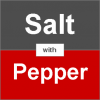 By Pepper Parr By Pepper Parr
July 15th, 2015
BURLINGTON, ON
There were two meetings – both took place at the same time, in the same room.
Many people were not fully aware of the meeting that mattered to Mike Wallace.
The scheduled meeting was the Burlington provincial Progressive Conservative Annual General Meeting at which a new board was installed. The other meeting, taking place at the same time was former Member of Parliament Mike Wallace creating the campaign team he will need in 2018.
Wallace is going to take a shot at getting the job as Mayor of Burlington.
Here is the time line he is working within.
The next provincial election is “scheduled” for June of 2018.
The next municipal election will take place in October of 2018.
At the Burlington Provincial Progressive Conservative riding association Saturday forenoon the new board was put in place.
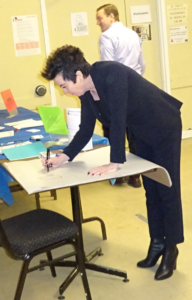 Nominee Jane McKenna at the Progressive Conservative AGM last Saturday? And it was announced that Mike Wallace as going to run Jane McKenna’s election campaign whenever the provincial election is called.
The municipal election date is cast in stone – the provincial election can take place whenever Kathleen Wynne decides to call it. The Burlington provincial Progressive Conservatives believe they are ready.
They appear to have the money in the bank and they now have a Board and an Executive that will do what Wallace needs them to do.
McKenna’s chances of getting returned to Queen’s Park are slim unless the Premier really screws up – and that may well happen.
For Mike it doesn’t matter all that much. He will put together a campaign team and do the best he can with what he has. Running Jane McKenna against Liberal Eleanor McMahon is an uphill battle – too early to attempt to call that one – except for the fact that McMahon is the much better campaigner. She has a genuine touch for people that McKenna is never going to be able to match.
 Can former MP Mike Wallace keep all those Tory blue votes when he runs for the office of Mayor in 2018? That too doesn’t matter – Wallace will do the best he can with what he has. He will put together a superb team; there are some very accomplished Tory political operatives in Burlington and the party still believes that the heart of this city is still conservative. I think Karina Gould has proven that may no longer be the case
This city has more than enough in the way of Tory party faithful who will heed the call and turn out and pull in the vote.
 The night of the last federal election, which Mike Wallace lost to Karina Gould. Mayor Goldring went to the Wallace campaign offices first and then went to the Gould campaign offices later to congratulate the winner. Did Goldring misread the tea leaves? What Mike Wallace gets out of this is a well-oiled campaign machine that he will use to propel him into city hall where he will get to wear the chain of office.
Wallace served as a city Councillor for a number of years and was the Member of Parliament for Burlington until Gould defeated him.
The race for Mayor of Burlington in 2018 looks like it will be between Rick Goldring, Mike Wallace and Marianne Meed Ward.
Wallace will eat into the Goldring voters – the Meed Ward voters will remain firm.

 By Pepper Parr By Pepper Parr
January 15th, 2017
BURLINGTON, ON
There were no fireworks – but it was a bigger Annual General Meeting of the Burlington Progressive Conservative Association than they expected. Additional tables had to be set up to accommodate everyone.
 Jane McKenna at the Progressive Conservative AGM last Saturday. Jane McKenna, now the candidate, worked the room but studiously avoided the table at which Jane Michael and her colleagues were sitting. Michael was the candidate that lost the nomination to McKenna.
McKenna was the Member of the provincial legislature for one term, elected in YEAR and lost to Eleanor McMahon in 2014 – putting an end to 70 years of provincial Tory rule in Burlington.
While there were ten tables set up there were just two that mattered,
The one with the defeated candidate and the other that is best described as the “power” table. This is where the heavy weights in the PC party in Burlington sat. Keith Strong, Mike Wallace, Paul Sharman – others we were not able to identify but certainly people who have been part of the organization for some time.
The agenda was the standard AGM deal.
 Mike Wallace – flipping burgers at a Chamber of Commerce event when he was the Member of Parliament for Burlington.  Keith Strong, one of the most powerful people in the room; doesn’t sit on the board but will have a lot to say about policy and strategy. Once he has decided to do something – it is going to get done. Brook Dyson asked that we not take pictures – we complied. Quite why they wouldn’t want photographs of a very full room was beyond this reporter.
The members were told that in the past membership had been around 250 – and was always pretty steady at that number.
Because there was a contested nomination campaign membership had shot up to more than 900 – the trick is going to be to keep them all and to get them out on the streets knocking on doors.
Jane Michael is reported to have brought in 350 new members; with the hard feelings that came out of the way the vote count during the nomination was handled there is little chance that the bulk of those members will be active.
Mention was made a number of times that there were youth groups being set up – but there weren’t any young people at the tables – other than the daughter of the nominated candidate.
A couple of odd things – there was a sheet of paper with a list of the people whose names were being put forward to serve on the riding association board.
An executive of five and 14 directors. The past president sits on the board but he was reported to no longer be involved.
Colin Pye, the lawyer who wrote the appeal against the nomination vote count asking that the results of the nomination vote be set aside (that appeal was denied) chose not to run for the board again.
The Jane Michael crowd felt they were robbed and attended the meeting partly in protest and to sit by helplessly as a new organization was put in place.
The slate of candidates Mike Wallace put forward was not opposed and there were no nominations from the floor.
At the top of the list of names was the letterhead of Mike Wallace’s new real estate operation. When asked why his name was at the top of the page Wallace said “it was the only paper I had”
It became very clear that this was the Mike Wallace slate – they were the people he wanted to go forward with when the election is called
Wallace is going to run the McKenna campaign.
Colin Gray, the financial officer gave a short report on how much money there was in the bank and what the new political donations rules are – donations from corporations and unions are out; individual donations are limited to $3600 during an election year and $2400 in a non-election year.
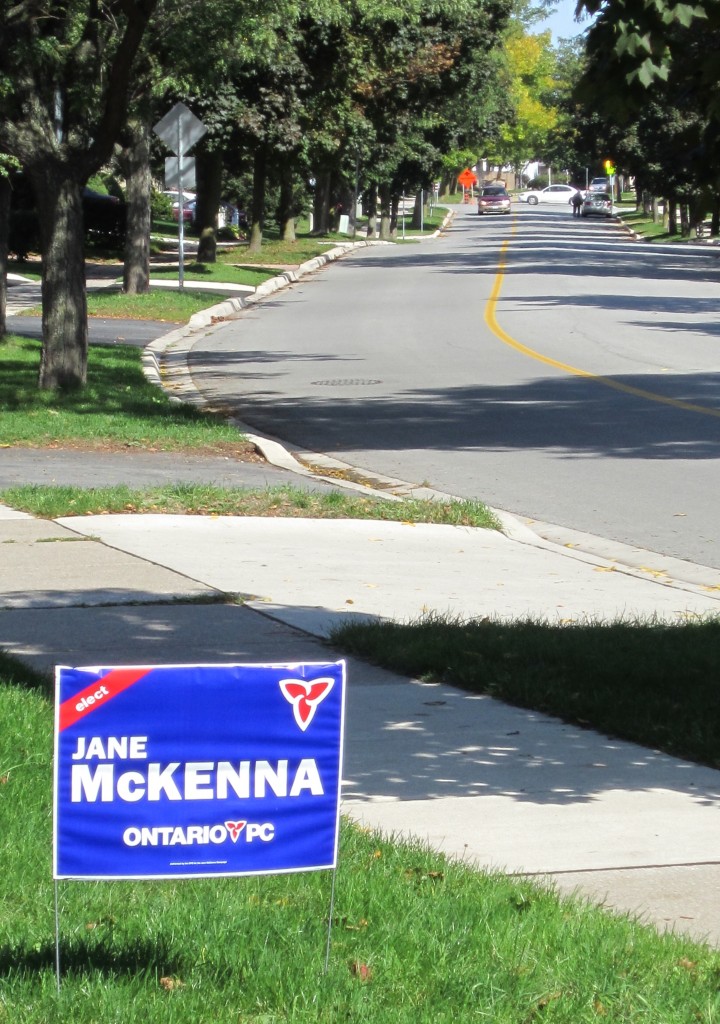 Expect to see signs like this when the provincial election is called. The organization believes it has more than enough money in the bank now to fight a 28 day campaign – which they pointed out could take place at any time. They want to be on a war footing as soon as possible.
Expect to see a lot of Jane McKenna in the next six months but don’t expect to see her at fund raisers – the new funding rules say the candidate cannot attend. Who wrote that rule?
Many people at the Saturday AGM felt that in the past the riding had been directed and controlled by the Toronto headquarters of the provincial Progressive Conservative party – they wanted to see that end.
Of the 19 member board 12 were new. No one from the Jane Michael team are on the board,
The board is now made up of:
Brook Dyson, president; Rene Papin, vice president election organization; Mike Clouse, VP membership; Archie Jollymore, treasurer; Bill Brown,secretary; Hugh Loomans, Kris Kowalchuk, Taylor McKensie, Alice Sterling, Paul Scherer, Sukhdev Takher, Rajpal Sidhu, David Stabkiewicz, Ann Curran, John Krasevec, Riley Thompson, Brenda Stewart, Mike Wallace and Larry Pedlar.
Ruth Roberts, who has been an active Tory for longer than she might want to admit asked some very probing questions at the close of the meeting: What has happened to us she asked. “We have fences to mend she said and added that there is a tough fight in 2018 and we are going to need young people to help us win it.
The problem was there were very few young people in the room that Saturday morning.
Those that were there left on a high note. They have their candidate; they have the money they need to run a campaign – all they feel they need is the date on which the campaign will start – and they expect to be ready for it.
Ruth Roberts had the most positive words – but she isn’t on the board.
Related editorial comment.

 By Pepper Parr By Pepper Parr
January 15th, 2017
BURLINGTON, ON
The development that council voted not to go forward with in the Alton Village got punted to the Ontario Municipal Board faster than the lawyers could lick the envelope and get the postage on it.
The city now has to go looking for legal talent to represent them on what is going to be a difficult case.
The city planner did her job – she asked council for specific direction – got it and set out working with the developer.
The project gets brought back, the community delegates against the project and council votes it down
The developer says he is “shocked” and notes that he never did like the Mayor; we now have personalities introduced to a sticky legal case.
 Planning department and council talked past each other on this project. Did the city manager not see the disconnection? Apparently not. How did this mess happen?
A regular reader, who is not identified for good reasons, wrote some comments that are strong enough to be passed along.
The writer is well qualified to make the comments:
“It’s obvious the city has a monumental challenge at the OMB, having to hire outside planners against the staff recommendation.
“I found watching the meetings on video revealing and alarming at how decisions are made at city hall. What struck me is how the planning department and council talked past each other, not understanding what the other was saying and what they were agreeing to. The planning department was presenting a new approach to handle the application – yet no one seems to have a hand on the tiller, guiding the process so ensure good decision making and mitigate the city’s risk.
 Director of Planning Mary Lou Tanner “Back at the July 11, 2016 meeting, the Planning Director was clear what she was asking for. Her focus was on seven design principles she identified and pointed out that she did not yet have agreement with Adi because two of these principles were not yet met:
Principle 5 – Implement tall building best practices. The modified design recommendations from staff (below) achieve this principle.
Principle 6 – Provide appropriate transitions between buildings. This is achieved with the modified design recommendations.
“She was asking council members to endorse the design approach and recommendations and direct staff to prepare an official plan and zoning bylaw amendment subject to these design recommendations (i.e. the remaining two principles) being met.
“When the majority of council voted in favour of the Planning Director’s requests, she thought she had their support to negotiate with ADI to make these design changes and develop recommendations based on the outcome of these negotiations.
Lots of talking; not enough listening.
“Back at the July 11, 2016 meeting, a few council members, including the Ward 6 councillor, expressed concern about the tower height. However, the report they approved never committed to reviewing the number of storeys, only “to optimize building placement and ensure an appropriate fit and transition in scale.”
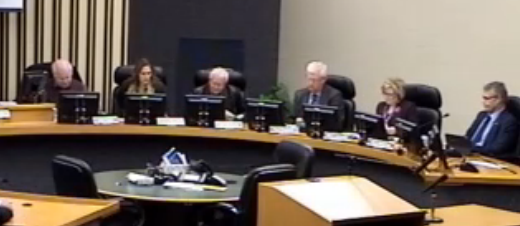 Is this city council so deeply into a group think that they no longer know ho to listen? “People were talking around the horseshoe, but seems like there was not enough listening. With no amendments to the report, it’s surprising that council would be surprised that the December report contained no changes to the number of storeys.
“Most of council didn’t seem to know what they were voting for, given the comments that this was just “going forward for discussion”. It wasn’t – the planning director was asking for approval to negotiate several design changes – but nothing to do with height – and in fact she did just that and brought back the file for approval. Their approval set off the chain of events that directly lead to Adi appealing to the OMB. We’re now in the soup we’re in because of that ill-considered decision and poorly thought through process.
“The director of planning never corrected the statements that this report was “just to continue discussions:” She should have been very clear about what she was asking. That lulled everyone, including the public, into thinking substantive changes were coming when clearly they were not – only the two design tweaks staff mentioned in the report. So the public didn’t show up in force till the 11th hour, and then council flips because as Tom Muir said, “it’s politics stupid”.
“Meanwhile, the public was ignored for months – with many council members waking up to their firm opposition only at the December meeting.
The lesson here is to:
a) know what you’re voting on;
b) get the public involved EARLY not at the end. I suspect (hope) this is the first and last time this process will be followed on a planning file given the mess it has created.
Chasing the shiny new object:
“The Planning Director’s recommendations were based on the Tall Building Guidelines – not the Official Plan or public input.
“The influence of outside consultants like Brent Toderian are obvious. From a professional perspective, city planners are captivated by the Vancouverism urban form, which they regard as the exciting, fresh approach to planning. They’re keen to import his thinking to Burlington.
“The Planning Director rushed through these guidelines earlier in the year, with most of council supporting her request, with only an “interim” proviso slapped on it.
“However, no effort was expended to get public input. Planning staff calls them “best practices”, but the guidelines have never been evaluated or debated to determine if Vancouver’s urban form is right for Burlington neighborhoods.
“An honest discussion on intensification desperately needed. This slipshod decision-making process is in the context of never having a healthy public discussion and getting broader buy-in on the right kind of intensification for Burlington.
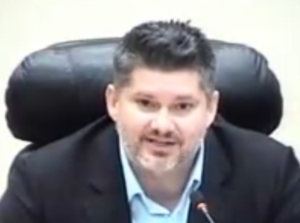 Consultant Brent Toderian – the chief evangelist for the tall narrow buildings on a podium-planning model. “The mayor had a “rah-rah” presentation at his Inspire Series – leaning heavily on Brent Toderian – the chief evangelist for the tall narrow buildings on a podium-planning model.
“We should be asking if intensification is the city’s highest ambition, or is it simply a means to a higher goal. Instead all we get are the empty “Grow Bold” platitudes.
“The lack of clarity on the meaning and limits of intensification, the disregard for the Official Plan and the embrace of the Tall Building Guidelines, coupled with the public being bypassed raises concerns about the nature of the relationship between the city’s planning department and the development industry.
“These factors breed uncertainty in our community for who decides what gets developed where.
“Once again, I wonder whose city is it?”
Indeed!

 By Staff By Staff
January 15th, 2017
BURLINGTON, ON
Sometime Monday forenoon Jim Young will take to the podium at city hall and brief members of Council on the 28 page document he prepared on what the Senior’s Advisory Council would like to see done with transit.
Jim Young has been advocating for better transit for some time. He came close to getting a change during the budget debates in 2016 when he wanted the city to make transit free for seniors on Monday’s.
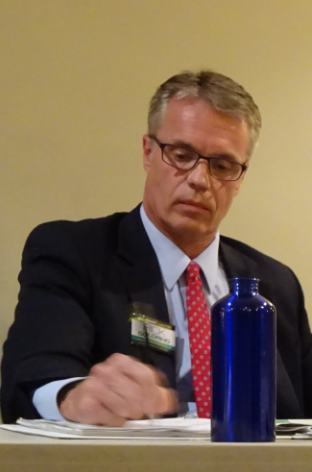 Mayor Rick Goldring voted for the transit pilot program in the 2016 budget. 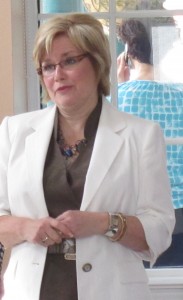 Ward 6 Councillor Blair Lancaster voted for the pilot transit program in the 2016 budget 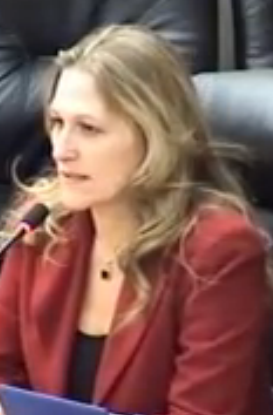 Ward 2 Councillor Marianne Meed Ward voted for the transit pilot program during the 2016 budget. The Mayor, Councillor Meed Ward and Councillor Lancaster voted for what was to be a pilot program. The Director of Transit at the time wasn’t for the idea. He has since left the city.
Councillor Craven is reported to have told an Aldershot resident that he liked the program – but he did not vote for it – that may have been because almost anything Councillor Meed Ward puts forward, Craven opposes. He didn’t speak at any length on the matter during the debate.
Councillor Paul Sharman voted no – he wanted more data. Councillor Sharman always wants more data before he makes a decision – there does come a point when a decision has to be made based on experience and wisdom. There was the sense that the asking for additional data was punting the ball off the field.
Councillor John Taylor voted no – saw free transit as social welfare which most people didn’t need. Councillor Taylor couldn’t help but see free transit as some form of social welfare; his mind is still stuck in that old style thinking.
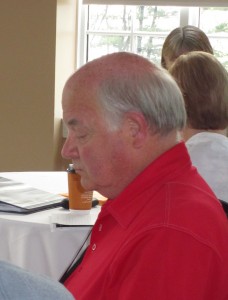 Councillor Taylor saw free transit as part of the social welfare system – a Regional responsibility. One wonders why Taylor does not label the $225,000 that is forgone in terms of parking fees for the free parking members of staff get every year. With that kind of money the city could make the transit service free to everyone.
Councillor Dennison voted against the proposal.
Young personifies persistence and so he will be at it again on Monday asking council to put more money into transit.
The paper he has presented was adopted by the Burlington Seniors’ Advisory Committee: November 14, 2016.
The chances that every member of council will actually read all 28 pages is slim.
Here is a short summary of what Jim Young wants your city council to do to improve transit.
Improving Transit for Seniors Improves Transit for All
Improved Frequency and Reliability of Transit Service
Synchronize Smaller Community Buses to Larger Bus Hub to Hub Routes
Routing community bus services through satellite Seniors Centres
Restoring Service Stops in Major Malls
A Return to 70/30 Division of Transit/Roads Gasoline Tax Funding
Filling the City’s Buses During Off-Peak Hours
 At busy holiday shopping periods buses get trapped in Maple View Mall – killing schedules. The Major Objectives of the BSAC Paper are:
To improve service and increase ridership of Burlington Transit.
To get more people out of cars and on to transit.
To move the city towards achievement of its 25 year Strategic Plan.
Contribute to growth in our city.
Reduce traffic congestion and improve road safety in Burlington.
Reduce CO2 emissions and help limit global warming.
Provide a safe, dignified means of transport for many who suffer restricted mobility.
Address the paradox that those most in need of public transit are those least able to afford it.
“Public transit is one of the most complex issues facing cities and indeed nations today. It poses a series of problems that are complicated and difficult to solve. Every city, every politician wants successful transit systems.
They move people, contribute to growth, reduce congestion, improve road safety, reduce CO2 emissions, help limit global warming, provide a safe means of transport for many who would otherwise suffer restricted employment and social mobility.
The paradox is that those most in need of public transit are those least able to afford it. The elderly, the young, the working poor, students, single parents, physically and intellectually challenged citizens and, returning to the elderly, those who have had driver’s licenses rescinded due to age related health issues.
Putting aside any notion of “seniors entitlement”, Burlington Senior Advisory Committee (BSAC) wants to add the voice of seniors’ experience, knowledge and love of our city to the transit debate. Of course we recommend improvements in transit that benefit seniors, but we do so very firmly from the perspective that: “Whatever Improves Transit for Senior’s, Improves Transit for Everybody”. This philosophical principle improves transit for our children and grandchildren, improves transit for Burlington and improves Burlington as: A City that Grows, A City that Moves, A Healthy and Greener City, An Engaging City, achieving all of the elements of our city’s 25 year strategic plan.
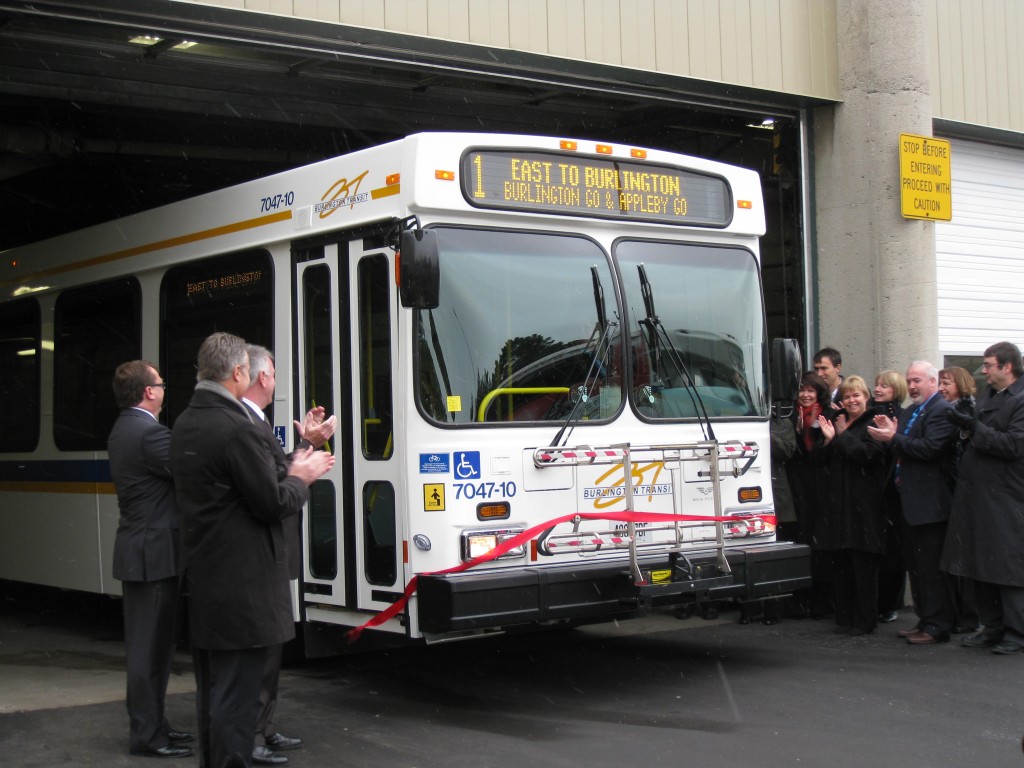 Burlington Transit getting new buses – to deliver less service. Among politicians there is an almost universal love affair with the benefits of public transit. This is logically offset by concerns about how cities will finance the level of public transit required to achieve all of our lofty goals. The dichotomy has always been whether to wait for increased ridership to justify the cost of improving transit or, to invest in improved transit and trust that the ridership will follow.
This BSAC position paper hopes to point a way that allows Burlington to take some simple, relatively inexpensive actions that will increase ridership, contribute towards some of the social and environmental issues facing every city, and offer medium and longer term improvements that might make Burlington Transit a model for other medium sized city transit systems which becomes a showcase for the city worldwide.
A number of weeks ago Young upbraided city council for forgetting just why they were eleted. At that time he said:
When you deny constituents the reasonable opportunity to advise you during council term at meetings such as this, you leave them no other option but to voice their frustrations through the ballot box at election time.
Look at recent election results, where voters vented their frustration at the perception that politicians are not listening, do not provide the opportunity for citizens to be heard, a perception that has given voice to the Fords, the Trumps and the Brexiteers who, bereft of policy or vision or even civil discourse, at least pretend to listen, pretend they will be the voice of the people.
Then proceed to undo all the good that has been done, the community that has been built by that slow and frustrating democratic process.
I will finish by challenging each of you who wish to limit the participation of citizens in the affairs of our city:
Will you please explain to this gathering tonight how limiting delegations to 5 minutes is good for our democracy, good for our city?
Will you then publish that explanation in your Newsletter for all your constituents to see and to judge for themselves?
Will you stand at your regular town hall gatherings and tell the people of your wards why you want to silence their voice?
Because you will stand before them in 2018 and they will demand to know.
The motion to reduce delegation time at Standing Committee from ten minutes to five was defeated – in some measure due to the comments Young made.
Will he manage to convince council to re-think the way they fund transit?

 By Staff By Staff
January 14th, 2017
BURLINGTON, ON
There is a neat little service the city has – you can go to a map and see which streets have been plowed.
Looking at a map to learn which streets have been plowed is nice – I guess.
What this map has though is something else – that is really useful.
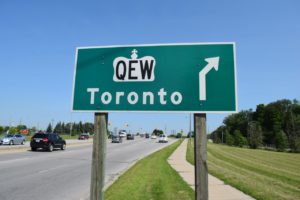 There are small symbols along the line that is the QEW – each of those symbols is one of the cameras that broadcast what the traffic load is like in real time. There are small symbols along the line that is the QEW – each of those symbols is one of the cameras that broadcast what the traffic load is like in real time.
You might want to book mark this one – really useful.
Click to check it out.

 By Staff By Staff
January 13th, 2017
BURLINGTON, ON
The Halton Regional Police Service (HRPS) is pleased to announce that its annual Toys for Tots holiday fundraising campaign raised $248,810 in toys, gift cards, cash and food for local families in Halton. All told, more than 4,350 Christmases were made brighter because of the generosity of area citizens, businesses, schools and sports teams.
 Not sure if that little girl returned the hat to the police officer. In its sixteenth year, this latest drive ran from November 15 until December 24, 2016.
“Once again, the people of Halton have gone above and beyond,” said Stephen Tanner, Chief of Police. “Residents, businesses and groups not only exemplified the spirit of Christmas; they gave us all another reason to be proud to call our Region home.”
For the past eight years, the Service has partnered with the Burlington Lions Optimist Minor Hockey Association (BLOMHA). This year, the organization raised more than $60,000, bringing their grand total to over $275,000. Their efforts are spearheaded by parent representative, Shari Carruthers.
Meanwhile, a local corporation, that wished to remain anonymous, donated $21,000 worth of toys.
Other community partners who made significant contributions include Budds Subaru, Burlington Cougars, Canadian Tire, East Side’s Auto Group, Halton Catholic District School Board, Halton District School Board, Georgetown Raiders, G.E. Water, Halton Honda, Longo’s Fruit Market, Mandarin Restaurants, Rotherglen School, Royal Bank, TD Canada Trust, Tiger Jeet Singh Foundation, True Mentality, and Woodbine Entertainment Group.
Sworn (uniform), civilian, Auxiliary and other volunteer Service members donated their time to support collection efforts at Canadian Tire locations region-wide, at each city/town Santa Claus Parade, at three Cram-a-Cruiser challenges, and at numerous other community events.
HRPS members raised more than $6,400 of their own funds through individual initiatives and platoon challenges. Service volunteers were also responsible for packaging and delivering toys to area families in their homes and in hospital.

 By Staff By Staff
January 13th, 2017
BURLINGTON, ON
Recall that piece we did on the men who were seen by police walking away from a dark coloured Mazda Protégé with a stolen licence plate in a parking lot near Appleby Line and Dundas Street in Burlington last on Thursday.
It was determined that the same vehicle and licence plate was involved in several armed robberies where a firearm was used and as a result, a perimeter was quickly established.
The two men were later found inside a nearby Starbucks.
 Police dog was used in the apprehension of the first two suspects. That two led to four males who were arrested. Charges being laid against all four individuals in relation to recent armed robberies in both Halton and Peel region.
Hassan ALI, 18 years of Mississauga
• Robbery with Firearm, Point Firearm, Disguise with Intent (Royal Bank – Oakville)
• Possession of Property Obtained by Crime (Burlington)
• Robbery with Firearm, Disguise with Intent (Macs Milk Store – Brampton)
• Robbery with Firearm, Disguise with Intent (Hasty Mart Variety Store – Brampton)
• Robbery with Firearm, Disguise with Intent (7-11 Convenience Store – Mississauga)
• Robbery with Firearm, Disguise with Intent (Macs Convenience Store – Mississauga)
Ibrahim MOHAMED, 18 years of Mississauga
• Possession of Property Obtained by Crime (Burlington)
Young person – 17 years of Mississauga
• Robbery with Intent, Point Firearm, Disguise with Intent (Royal Bank – Oakville)
• Possession of Property Obtained by Crime (Burlington)
Young Person – 16 years of Mississauga
• Possession of Property Obtained by Crime (Burlington)
• Robbery with Firearm, Disguise with Intent (Mac’s Milk Store – Brampton)
• Robbery with Firearm, Disguise with Intent (Hasty Mart Variety Store – Brampton)
• Robbery with Firearm, Disguise with Intent (711 Convenience Store – Mississauga)
• Robbery with Firearm, Disguise with Intent (Macs Convenience Store – Mississauga)
All four accused were held in custody pending a bail hearing in Milton Court on January 13th 2017.
A lot gets done when observant police officer are on the job.
Anyone who may have further information pertaining to these incidents is asked to contact the Oakville Criminal Investigations Bureau at 905-825 4747 ext. 2216, Crime Stoppers “See something, Hear something, Say something” at 1-800-222-8477 (TIPS, through the web at www.haltoncrimestoppers.ca or by texting “Tip 201” with your message to 274637 (crimes)

 By Pepper Parr By Pepper Parr
January 13th, 2016
BURLINGTON, ON
That December 8th meeting that was held by the Halton District school board has come to be an experience the Board has learned something from.
Trustees were telling staff that many people didn’t feel they had had a real opportunity to ask questions or voice their concerns.
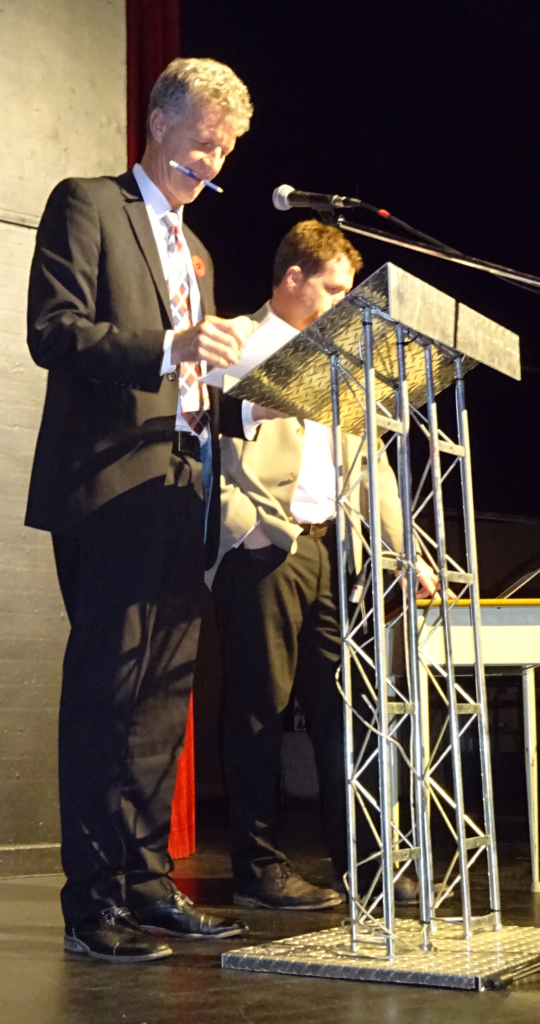 Director of Education Stuart Miller getting ready to address parents at Central high school. Director of Education Stuart Miller admitted that there was something to be learned from that first experience and has said that the Board’s administrative committee will review what has taken place so far and decide if there should be another public meeting at which people can voice their concerns and grievances.
Miller didn’t sound all that happy with the idea of a meeting at which he has to stand up in front of a couple of hundred unhappy people who get quite emotional about the possibility that there local school might be closed.
But he did say that if the view was that another public meeting was necessary then he would take part and listen.
Miller isn’t sure what the public expects. He refers again and again to the facts he has to deal with – 1800 empty seats – something that just isn’t sustainable on a long term basis.
He argues that the data provided by the Boards Planning department has been accurate in the past and he believes that what he is getting from them now is also accurate.
That might not really be the case.
The board was caught by surprise when it found registration at the Alton public school to be much higher than projected – then realized that a significant number of the houses in the relatively new community was housing two and sometimes three families.
These elementary school students will move on to the high school in the community which is already well over its intended capacity.
Miller told staff that his planners work closely with the city of Burlington and share information.
One of the problems is that the city can only pass along what it has in hand in the way of new residential projects. There is a project well past the drawing board stage for the intersection of Brant and Ghent streets that will involve three of the four corner properties at that intersection.
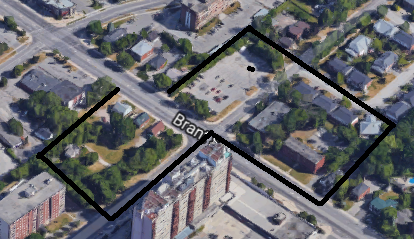 The properties within the black outline are part of a development that is well past the drawing board stage. The hold up is at city hall where the planners need more time to figure out how this will fit in with their mobility hub plans. City hall has asked the developer to wait a little longer before talking about the development – which means that development is not real yet from the city’s point of view. The plan is for there to be a mobility hub at the Burlington GO station where a five tower project is currently under construction. The city to get its mobility hub thinking completed before looking at additional new projects.
The developers are way ahead of the city. They have measured the market, done their research and determined what the public wants and have put their money on the table and begun construction.
It is very real in the minds of the developer – several housing were recently demolished to clear the Brant Ghent site.
The board isn’t even aware of that development which is a couple of blocks from Central high school.
There also appears to be an assumption that there will be very few families living in the five condominiums that are going to be part of the Paradigm project on Fairview next to the GO station.
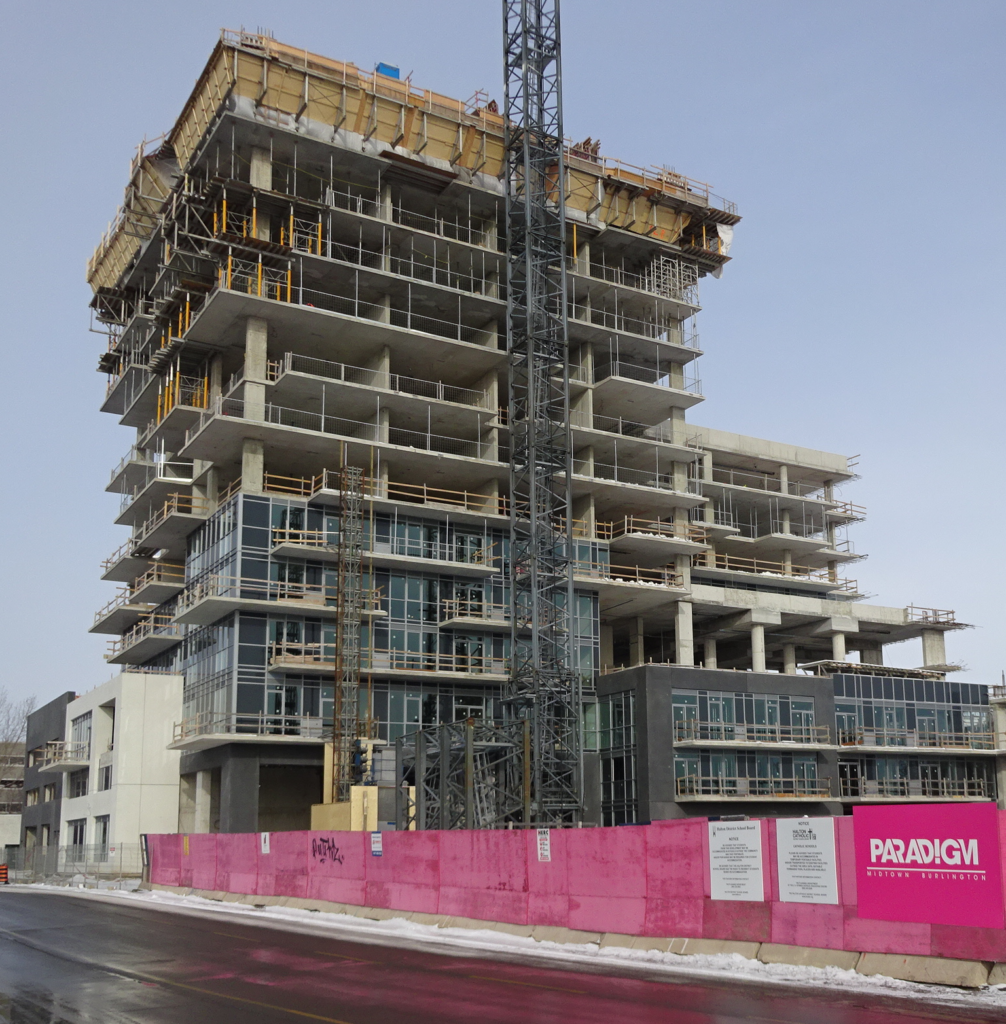 A five tower project currently under construction is less than a ten minute walk from Central high school. To assume that a community of 2000 people is going to be made up of foot loose and fancy free singles or seniors that want to downsize may turn out to be a mistake equal to the problem that cropped up in the Alton village when the board got caught with close to hundreds of additional students.
The board of education needs to find a way to meet privately with the larger developers to get a sense of where they want to go long term. There is vital data that is being missed.
The sense one gets is that the Planning department isn’t all that sophisticated and appears to rely on the tried but not always true demographic tools when perhaps something that permits the planners to dig down a lot deeper is needed.
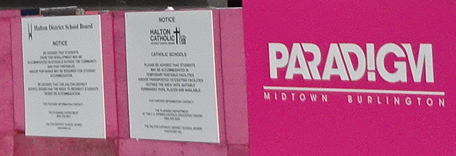 School boards know about the project – their signs warn parents that there may not be space in local schools for any children living in the project. There is little argument that the role of the board is to educate our children – but the job doesn’t stop at that border – an education is vital – a community is the space within which the student is going to exist and make their mark in this world.
There is a lot more talking to be done and some parents at Central high school are not convinced that the board really wants to listen.
One parent sent in these comments: “I think the PAR process will be a sham. But the Ministry designed it so it would be. There are PAR committee members in Ontario quitting in disgust of the whole thing before it’s even over. I talked with our MPP Eleanor on my thoughts about all this from a provincial perspective a while ago. She actually said “there is nothing wrong with the funding formula” and “I have faith in the process.” Our meeting was over the phone so I couldn’t tell if she said it with a straight face or not, but really!
There are two public meetings scheduled as part of the PAR process – no word yet on the format of those meetings.


 By Staff By Staff
January 12th, 2017
BURLINGTON, ON
Identity theft is real – very real.
The Halton regional Police got to see it happening here in Burlington when they investigated a call from the Royal Bank located on Pearl Street in Burlington where branch staff had alerted police to a fraud in progress on January 11th 2017 shortly after 1:00 PM.
It was reported that a male was attempting to open a personal and business account using fraudulent identification.
 Police arrived and after some investigation, it was confirmed that the male was not who he claimed to be and was arrested for fraud. The male provided a name and date of birth which was also later determined to be false. Police arrived and after some investigation, it was confirmed that the male was not who he claimed to be and was arrested for fraud. The male provided a name and date of birth which was also later determined to be false.
Upon arrest, the male was found to be in possession of fraudulent identification and various debit/credit cards in various names.
The male was properly identified as Jonathon William KELL (28 yrs-old) of No Fixed Address (formerly from Oakville). Kell was held for bail and charged with the following offences:
• Personation with intent
• Identity fraud
• Possession of a counterfeit mark
• Unauthorized possession of credit card data
• Obstruct Peace Officer
• Fail to Comply with Recognizance
Anyone with information is asked to call the Halton Regional Police Service – Regional Fraud Unit at 905-825-4747 ext 8739 or Crime Stoppers “See something, Hear something, Say something” at 1-800-222-

|
|













































































 There are small symbols along the line that is the QEW – each of those symbols is one of the cameras that broadcast what the traffic load is like in real time.
There are small symbols along the line that is the QEW – each of those symbols is one of the cameras that broadcast what the traffic load is like in real time.







